

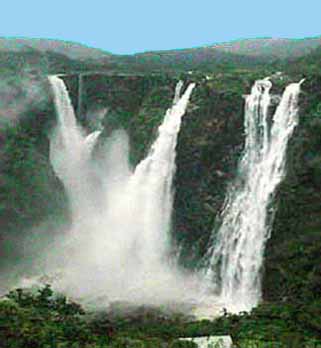

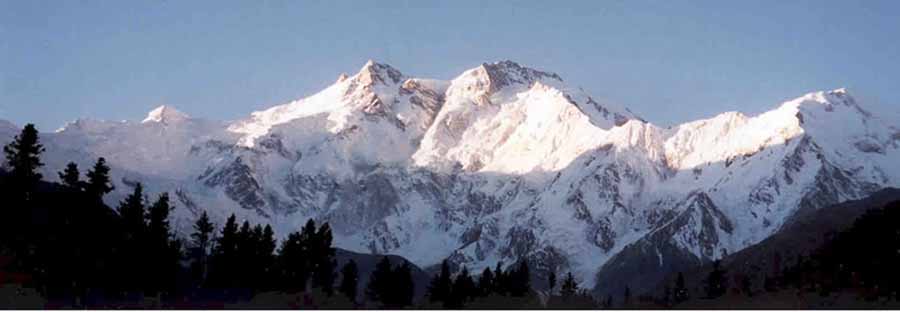
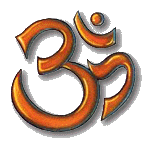
OM Voice
Root of the Civilization
NATIONAL LANGUAGE OF BHARATA:
SAMSKRITAMVEDIC JANA = KNOWLEDGE
OM: Devine Voice while self-creating the Brahmanda/Cosmos: AhdiDevam
OM became the Vedic Mantra of the Brahmanda [Cosmos]
BHARATA: Original Title

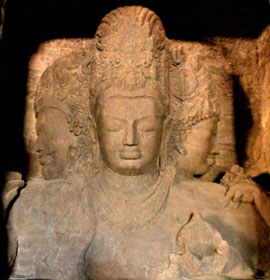
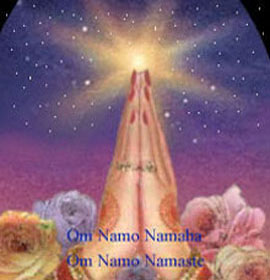
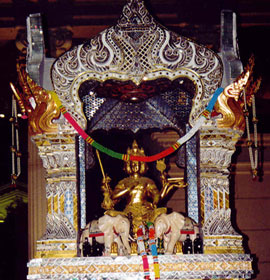
 ISHWARAM: BRAHMA - VISHNU - SHIVA: Indus Vedic scientific deities are similar to Proton, Neutron and Electron: each have different functionalities within the nucleus. The BRAHMA, VISHNU, and SHIVA were divine rulers of BharataRarsba during the Satya Yuga. Rest of the religions followed Indus divine Trinity system.
ISHWARAM: BRAHMA - VISHNU - SHIVA: Indus Vedic scientific deities are similar to Proton, Neutron and Electron: each have different functionalities within the nucleus. The BRAHMA, VISHNU, and SHIVA were divine rulers of BharataRarsba during the Satya Yuga. Rest of the religions followed Indus divine Trinity system.
Guru Brahma, Guru Vishnu, Guru Deva Maheshvara



VEDAS are the DIVINE CONSTITION of BHARATA
Recited by 

Yajurveda 40.1: the Brahmanda (Cosmos) is embedded within and ruled by the One and Only, One Supreme God 'Ishwaram'/ 'Parameswara'. Never dare to do any injustice OR desire riches through unjust means. Instead follow the righteous path and enjoy his bliss. After all he alone is the source of our bliss! Rigveda 10.48.1: 'Ishwaram' alone is omnipresent and ruler of the Brahmanda. He alone provides victory and eternal cause of Brahmanda (Cosmos). All souls should look up only to Him in the same manner as children look up to their parents. He alone provides for our sustenance and bliss. Rigveda 10.48.5: 'Ishwaram' enlightens the entire world. 'Ishwaram' is undefeated and undying and He is the light of the Brahmanda. All souls should seek bliss through seeking knowledge and acting thereupon. They should never shun the friendship of 'Ishwaram'. Rigveda 10.49.1: 'Ishwaram' alone provides true knowledge to truth seekers. 'Ishwaram' alone is promoter of knowledge and motivates virtuous people into noble actions to seek bliss. 'Ishwaram' alone is the creator and ruler of the Brahmanda. Hence never worship anyone else except One and Only 'Ishwaram'. Yajurveda 13.4: there is 'One and Only One' supreme Creator and Ruler of the Brahmanda. He alone is sustaining the earth, sky and other heavenly bodies. 'Ishwaram' is Bliss Himself! Ishwaram alone deserves to be worshipped by all humans. The modern Hindus have to understand that Ishwara is not a mythical destroyer Shiva. The Brahma, Vishnu and Shiva are the Vedic deities the creator, maintainer and destroyer of the Brahmanda only through the eyes of 'Ishwaram' within the divine nucleus - all three Vedic deities reside within Him. The divine Ishwaram is the Parameswara. The Vedic' core principles are embodied in the Old Testament, New Testament [Christian Bible] and Islamic Koran, especially the details of Bhavishya Purana and Indus cosmology.
Atharvaveda 13.4.16-21: 'Ishwaram' is neither two, nor three, nor four, nor five, nor six, nor seven, nor eight, nor nine, nor ten. He is, on the contrary, 'One and Only One' Supreme God. There is no other 'Ishwaram' except Him. All three Vedic deities reside within Him and controlled by Him. So, 'Ishwaram' ' alone should be worshipped, none else. Atharvaveda 10.7.38: 'Ishwaram' alone is the greatest and worth being worshipped. He is the source of all the knowledge and all the cosmic activities. Yajurveda 32.11: 'Ishwaram' resides at each point of the Brahmanda (there are more than million Galaxies). No space is devoid of 'Ishwaram' and He is the self-sustaining and does not need help of any angel, prophet OR incarnation to perform His duties. The soul that is able to realize this 'One and Only One' Supreme Ishwaram achieves Him and enjoys unconditional ultimate bliss OR Moksha. There are innumerable such mantras in the Vedas that explain 'One and Only One' supreme Ishwaram and instructs us to worship 'Ishwaram' directly. Please note: 'Ishwaram' is the Maheshvaram, Mahatmana, Paramesvaram OR Paramatma, only to identify 'One' Supreme God within the divine nucleus.






Over 90% of the Bharatian subcontinent people were African origin – assimilation throughout the subcontinent including their various foolish deities, rituals, dialects, all the eighty different sari styles, traditions, cultures, jewelries are intact to this day across the Bharatian subcontinent. Only modern Sanskrit of 2900 BC and Prakrit were Indus origin languages. Hindi dialect is once known as Arwadi also African origin. It is foolish to designate Hindi as a national language of Bharata over the divine inspired Sanskrit and it is unwise to popularize Hindi dialect through various mediums. Note: ancient Indus White human races (in those years an average human height was 15-18 feet) migrated across the greater Central Asian to present day European regions - tens of thousands years before the World War MahaBharata of 3115 BC - assimilating with the ancient African Albanos who settled in those regions. All the spoken ancient Indus languages/dialects of those years were became spoken dialects of ancient Central Asian and European land – tens of thousands years later in the modern era it is famously known as Indo-European language families. Ancient dialects like English, French, Dutch, Spanish, Latin, Greek ……etcs……today all those spoken modern languages/dialects in that region have root to the ancient Bharata. In other words, ancient Bharata was the lighting rod for rest of the whole world including manufacturing Vedic era Vimana, Science, Meditation, Yoga, Mathematics, Philosophy, Astronomy, Cosmology, Astrology and Calendar system. The well built African Albanos reached the present day European continent after the last ice-age 40,000-years ago: BBC genetic science - such TV production was First televised in 1982 through PBS in the United States. Q: when was the last ice-age? Some scientists dates back 40,000-years and some argues 25,000-years-ago. Readers could take a wild cosmological guess: clues - what is - 24,000/25,630/25,772-year cycle.
The ancient nation Bharata started to shape its destiny by adopting a democratic process from 1947, after fifteen thousands years of deep rooted great heritage and culture. The secret of Bharata's success with the experiment in the democracy can be found in ancient wisdom mainly in the Four Vedic scriptures, mainly 108 Upanishads and other important Indus scriptures. Once Bharata was leading the ancient world in science, Astronomy, Cosmology, Philosophy and Mathematics where they have established Taxila University around 550 BC when the whole world was in the dark ages and the famous Nalanda University in 427 AD during the decline of Roma Empire. Also established twenty elite schools across Bharata including Nyaya and Vaisesika/Vaisheshika is one of the six Indus Vedic system schools of philosophy, which developed elaborate theories on how atoms could be combined into more complex objects ultimately driven by the will of divine Ishwaram: originally composed by the sage Kanada around 600 BC. The decline of Bharatiya science was during the medieval ages because of the numerous foreign invasions including Greeks from Central Asia, subjugation and eventually Islamic and European exploitations for 950 years say roughly from 1000 AD.
 1. The History of Ancient Mathematics
1. The History of Ancient Mathematics  2. History of Ancient Mathematics
2. History of Ancient Mathematics
During the Islamic and European dominations, Bharata's history, Mathematics, Astronomy, Cosmology, Philosophy, core principle of Shanatana Dharma, the Vedic traditions, and all the scientific and spiritual Indus scriptures were interpreted from the Western paradigm and ridiculed to the extent that Bharatians have lost their faith in their scriptures once deeply rooted in Bharata. The people who have studied ancient Indus scriptures wonder-struck by the achievement of the ancient Hindus about their higher scientific knowledge that they have possessed are in tandem with the modern scientific research. The expressions of scientific opinions contrary to popular OR religious beliefs were common during the Vedic era. The religious persecution bears testimony to the spirit of tolerance in Bharata's Indus culture, except in the Varna caste system. A brief overview of some remarkable achievements of ancient Hindus will emit a flash of light on the depth of their scientific knowledge in various fields specifically in the filed of Battery powered technology, Vimana, Science, Mathematics, Vedic era Astronomy, Cosmology, and Astrology. From 2150 BC through 1200 AD series of African mass migration settled in the divine land of Bharata and that was the turning point in her history. So, African migration into Bharata complicated the demography and their assimilation throughout the subcontinent of Bharata what we see today.
In the year 476 AD, modern Indus mathematician Aryabhatta concluded that the earth is elliptically orbits around the Sun and simultaneously revolves in its own titled axis. The ancient Bharata invented the basic mathematical numbers from Zero to Nine and infinity; these are the outstanding contribution of Hindus to the rest of the world. The Hindus not only developed the Indus mathematical numerical system but also decimal system that spread to Arab region around 700 AD. Eventually Indus-Arabic numerical system reached Roma Empire, the capital Roma and the Western Europe around ninth century. In Vatican Pope ordered the inquisition if anyone tries to use Indus-Arabic numerical system except Roman numerals. Ancient Hindus laid the foundation for the modern mathematics and the scientific advancement in Vimana (airplane), Astra (rocket), Cosmology, and Aatronomy. The First modern rocket was invented and launched in the late1770s against the British army in the southern Bharata when the United States was fighting for their basic independence from the British. In the following pages details the list of ancient Indus Mathematicians and the elite educational institutions across the divine land Bharata.
The ancient Indus text of Agastya Samhita describes the method of making Electrical Battery where water can be split into oxygen and hydrogen. When we talk of gravity, Newton comes to our mind, but it is stated in the re-composed Indus scripture Surya Siddhanta dated around 400 AD, where Bhaskaracharya describes in details. All "Objects fall to the earth due to one force, and the Sun, Earth, Moon, planets, constellations are held in certain orbital position because of that One Force."
Albert Einstein wrote: we owe a lot to the ancient Bharatians, who taught us science, astronomy, cosmology and mathematics, without which no worthwhile modern scientific discovery could have been made.
Lin Yutang (1895-1976), a Chinese scholar and author wrote, "Ancient Bharata was China's teacher in trigonometry, quadratic equations, grammar, phonetics and philosophy." He states that ancient Bharata conquered China without sending a single soldier, peacefully spreading Buddhism across China and Far Eastern kingdoms.
Mark Twain (1835-1910), lecturer and writer wrote, "Ancient Bharata is the cradle of the human race, the birthplace of human speech, the mother of history, the grandmother of legend, and the great-grandmother of tradition. Our most valuable and most attractive materials in the history of man are treasured up in Bharata only." Note: in this modern era, after the Islamic, Portuguese, French, Dutch and the British domination for nearly 950 years, and Bharata became a dirt land along with her confused hundreds of millions of subjects.
William Durant (1885-1981), an eminent American historian wrote, "Ancient Bharata was the mother of our race and earlier Samskritam is the mother of Europe's languages. She was the mother of our philosophy, mother through the Arabs, of much of our mathematics, mother through Buddha, of the ideals embodied in Christianity, mother through village of self-government and democracy. Mother Bharata is in many ways the mother of us all." * Note: Islamic numerous invasions and their dominance and European occupations for 950 years, systematically destroyed Bharata's ancient twenty colleges and famous Nalanda University in 1197 AD.
The Vedic Cosmology is another form of ancient Vedic science, mathematics, and astronomy to name a few Surya Siddhanta, Vishnu Purana and Brahma Sutra. This can be confirmed by the modern scientific findings and is acknowledged by well-known modern scientists and authors, such as Carl Sagan and Count Maurice Maeterlinck of France, who recognized that the Cosmology of the Vedas closely parallels to modern scientific findings.
Voltaire (1694-1778), the famous French writer and philosopher stated, "Greek Pythagoras went to Varanasi to learn geometry." A statue of Pythagoras is still seen in Varanasi. Abraham Seidenberg, author of the authoritative "History of Mathematics," credits the Sulba Sutras as inspiring all mathematics of the ancient world from Babylonia through Egypt to Greece. The theorem bearing the name of the Greek mathematician Pythagoras is found in the Shatapatha Brahmana as well as the Sulba Sutra, the Bharatiya mathematical treatise, written centuries before Pythagoras was born in Greece. Note: this is funny to state from 1948 the modern Bharatiya government and school officials decided to teach westernized science and mathematics, other than ancient Bharata's education systems. This is the sad part of the modern Indus history of Bharata and dirt politicians.
Jean-Claude Bailly (1933-2007), French astronomer, corroborated the antiquity and accuracy of the Vedic astronomical measurements as "more ancient than those of the Greeks, Babylonians or Egyptians." He added that "the movements of the stars were calculated more than 5,200 years ago by the ancient Indus Maharishis/scientists during the Vedic periods, and it does not differ by a minute from the tables of modern findings."
Chess (Shataranja OR Ashta Pada) was re-invented around 600 BC in ancient Bharata and in the later years Chess was spread into Persia, Afghanistan, and Central Asia: the inhabitance of these countries once were migrated ancient Bharatians thousands of years before MahaBharata War of 3115 BC. In 400 BC, the Chess game became popular throughout ancient Bharata among the royal families, courtiers, military, and the elites.
Polo was first played in the western region of ancient Bharata and later years it was played in eastern Persia between the years of 400 BC to First century AD. The Rajasthan Rajahs mastered the Polo Match, and eventually Polo was spread throughout northern Bharata and some Far Eastern nations. In the modern Manipur, the Polo Match was traditionally played with seven players on each side. Later years, Polo was played in Cambodia under King Suryavarman, and Sri Vijaya Empire. In 1860 the British popularized the Polo Match; however, the British never won a Polo Match against the Rajasthani Rajahs.
Julius Robert Oppenheimer (1904-1967), the father of the modern atomic bomb, stated, "the Vedas are the greatest privilege of this century." During the test of the First Atomic bomb at the New Mexico desert, Oppenheimer reads Bhagavad-Gita, chapter-11, combined verses of 12 and 32 "If the radiance of a thousand Suns were to burst at once into the sky, that it would be like the splendor of the Mighty One," and "I (divine Atom) become the Death, and Destroyer of the World." The original verses were from the MahaBharata War text.
The spiritual language ancient Samskritam Brahmi Scripts has perfect phonetics amongst world languages. The Bharata's linguist Pinnani's grammar is an excellent book showing the depth of language development. Sir Monier William's, a 17th century Samskritam scholar, wrote that "The Pinnani grammar reflects the wonderful capacity of the human brain which till today and no other country has been able to produce except ancient Bharata and the modern education system of the western world have their roots in ancient Bharata." The great historian William Durant (1885-1981); an eminent American historian, in his book "Story of Civilization; Our Oriental Heritage," described ancient Bharata as the most ancient civilization on the earth, and "Bharata is the mother of our race and ancient Samskritam (Brahmic Scripts) is the mother of the European languages." The ancient Bharata is the mother of our modern and Greek philosophy. Note: Samskritam is the most suitable language for computer software that reported in the Forbes magazine, July 1987 issue.
Pachisi is a board game invented in ancient Bharata prior to the world war Mahabharata, about 5,200 years ago, and once it is described as the national game of Bharata. The Pachisi game was played between Pandava and Kaurava kings perhaps around 3,128 BC until Pandavas lost their kingdom for thirteen years. The Kaurava kings refused to honor their pledge to return the Pandavas' kingdom on the thirteenth year, presumably that led to the Mahabharata War, defeating the entire Kaurava army of Central Asia, Middle East, and Eastern European regions. The game Pachisi is played on a board shaped like a symmetrical cross. A player's pieces move around the board based upon a throw of six or seven Cowrie shells (sea snail), with the number of shells landing aperture upwards indicating the number of places to move. In the Aztec ruins in Mexico, vestiges of a similar game have been found called Patolli. The ancient Bharatiya Pachisi game was commonly known as Patolli board game during the Maya, Toltecs, and Aztecs Empire eras in the Middle America (Patala Loka). The westernized version of the game is spelled Parcheesi.
TAXILA: World's First Famous University
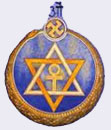

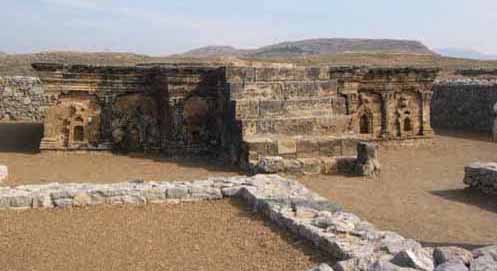

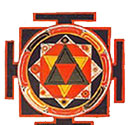

The ancient Bharatiya kingdom of Taxila once regarded as the educational capital of the world by the Greeks, Middle Easterners, and Central Asians.
The ruins of Taxila/Takkasila; the Vedic philosophy educational Center of Ancient Bharata (550 BC-326 BC), where various Sixty subjects were taught there.
In 1980; Taxila (Takshashila or Takkasila University) was declared as UNESCO World Heritage Site with its multiple locations.
The world's First University Takshashila was established at Taxila, western ancient Bharata, around 550 BC, when the whole world was under the Dark Ages. Thousands of students from the Central Asia, ancient Greeks, Egyptians, Mesopotamians, Tibetans, Hebrews, and elite Bharatians studied more than 60 subjects at Takshashila University. The Macedonia Alexander's invasion to ancient western Bharata in 327 BC ended the ancient educational learning center of Takshashila. The word Takshashila in Samskritam means "belonging to the Rajah Taksha." In 460 BC, the Modern Greek historian Herodotus, with numerous prospective Greek students, arrived in Taxila to study at Takshashila University, making references that Takshashila influenced Greek culture, and Greek students at Taxila became the great philosophers in Greece. At Taxila the teachings were bilingual for the better part of the two hundred years where old Greek became the second language. Basically Takshashila was a Vedic Learning Center and their famous teacher was Chanakya, and he influenced local warrior Chandragupta to became a First Maurya Emperor.
Some Buddhist scholars date Takshashila's existence back to 600 BC. It became a well-known higher learning Center at least several centuries by the neighboring nations, and continued to attract students from the numerous Central Asian kingdoms, Tibetans, and Mesopotamians, until the Alexander Macedonian invasion to the city in 327 BC. Generally, a student enters Takshashila at the age of sixteen. The subjects were, secretive science of Vedas, mathematics, astronomy, philosophy, Ayurvedic medicine, and shastras were taught, as well as the eighteen Arts, which included skills of archeries, elephant lore, Tantra Yoga, meditation, Universal Law of Nature, and military rulers. Today, Taxila is situated at the western part of Islamabad, northwest of Rawalpindi, Pakistan, which is the western region of ancient Bharata. Thomas the Apostle is still honored in Taxila in an annual festival in early July attended by thousands, celebrating the passage of his bones through Taxila on their way to Edessa.
NALANDA: World's Second Famous University
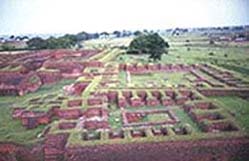

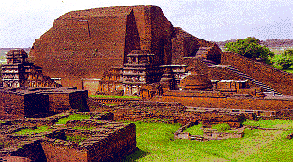


The world Famous Second University Nalanda was established in 427 AD located at the eastern Bharata about 55 miles southeast of Patna. It was one of the greatest achievements of ancient Bharata in the various fields of education systems. The Islamic invaders took Six months to burn the Nalanda University in 1197 AD under the command of notorious Muslim invader Bakhtiya Khilji, and once it had over nine million books (Mandalas). At least five percent of the volumes, about a few hundred thousand books, were secretly transferred to Nepal and Tibet for preservation. The Chinese scholars Zhang Wen Ming, I Ching, and Yi Jing translated a large number of Nalanda's Indus Mandalas from Samskritam and Pali to Chinese.
Nalanda University was one of the world's First residential Universities built in an area of ninety-four square miles land with dormitories for students. In its' heyday it accommodated over 10,000 students and 2,000 teachers. The university was considered an architectural masterpiece, and was made of lofty brick walls with one major main gate. Nalanda had eight separate compounds and ten temples, along with many other meditation halls and classrooms. On the campus there were a few Lakes and Parks. The library was located in a nine-story brick building where meticulous copies of texts were produced. The subjects were taught at Nalanda University included Science, Mathematics, Astronomy, Cosmology, Vedas, Puranas, and Upanisdhs. The Nalanda University attracted students and scholars from Korea, Japan, China, Tibet, Burma, Thailand, Cambodia, Malaysia, Indonesia, Central Asia, Mesopotamia, Greece, and the Eastern Roma Empire. The Tang Dynasty Chinese pilgrim Xuanzang left detailed accounts of the Nalanda University in the seventh century AD. The Nalanda's famous teacher was Arya-Bhatta (476–550 AD). The destruction of Nalanda University was the end of ancient Bharata's superiority in science, mathematics, astronomy, alchemy, cosmology and anatomy, mainly because of the Islamic domination for 400 years, until the British East India Company was arrived in 1601 AD. The some modern Bharatians are mastering their ancient knowledge in Vedic science, mathematics, cosmology and astronomy. The ancient culture, languages, science, mathematics, astronomy, cosmology and temples of Bharatiya subcontinent were systematically destroyed by the Islamic rulers. The intellectual modern Bharatians are heading back to their ancient Bharata's milestone in Vedic Science, Astronomy, Cosmology and Mathematics.
The ruins of Nalanda University, ninety four square miles complex is situated at Patna, Bihar, eastern region of Bharata. In 1948-49, China invaded Tibet destroying over sixty Buddhist monasteries, stealing thousands of Nalanda University Indus scriptures, which were stored from the Islamic invaders in 1197 AD
On December 09, 2006, the New York Times detailed a plan to rise one billion through various groups to revive Nalanda University near the ancient site. A consortium led by Singapore and including China, Bharata, Japan, and other nations would attempt to raise $500 million to build a new Nalanda University and another $500 million to develop ancient infrastructure. On June 12, 2007, News India reported that the Japanese diplomat Noro Motoyasu said that "Japan will fund the setting up of a Nalanda International University, in Bihar." The proposed University would be fully residential, like the ancient Nalanda University of learning center. In the first phase of the project, seven schools with 46 foreign faculty members and over 400 Bharatiya academics would take part. The University would impart courses in sciences, medicine, mathematics, astronomy, cosmology, philosophy, and spiritualism along with other subjects. Finally, on September First of 2014, at Rajgir, Bihar, a new similar Nalanda University is opened for students, and rest of the entire modern University campuses is completed in 2020 AD and opened its door to all the students to study in 2021.
On September First 2014, at Rajgir, Bihar, New Nalanda University is opened for students; the entire modern campuses was completed in 2020 AD and fully opened to all students from 2021.

1930's Bose-Einstein Theory: Dr. Satyendra Nath Bose was the First Bharatian Nuclear scientist in the modern era. A Bose-Einstein condensate owes its existence to peculiarities of quantum physics, including some important distinctions between two fundamental types of matter - Fermions and Bosons. Fermions include electrons and the quarks that make up Protons and Neutrons within the nucleus of an atom. Bosons include the particles that carry fundamental forces; these include the Photons that carry light and other forms of electromagnetic forces. Two Americans and a German-born scientist shared the 2001 Nobel Prize in physics for "the achievement of Bose-Einstein condensation in dilute gases of alkali atoms and for early fundamental studies of the properties of the condensates."
Sir Jagadish Chandra Bose (November 30, 1858 - November 23, 1937), was a Bengali physicist and science fiction writer, who pioneered the investigation of radio and microwave optics, made extremely significant contributions to plant science, and laid the foundations of experimental science in the subcontinent of Bharata. He is considered as the father of Radio Science. Sir. Jagadish Chandra Bose was the First scientist from Bharata to get a United States patent in 1904. * Note: Ramanujan Srinivasa's universal infinite series led to Theory of Relativity by Albert Einstein, which he unable to prove it in his life-time.
Satyendra Nath Bose (January 01, 1894 - February 04, 1974), was a Bengali physicist, specializing in mathematical physics. He is best known for his work on Quantum Mechanics in the early 1920's, providing the foundation for Bose-Einstein statistics and the theory of the Bose-Einstein condensate. Although more than one Nobel Prize was awarded for research related to the concepts of the boson, Bose-Einstein statistics and Bose-Einstein condensate - the latest was the 2001 Nobel Prize in Physics, which was given for advancing the theory of Bose-Einstein condensates. Satyendra Bose himself was never awarded the Nobel Prize in Physics. Because of that, in 1921 Albert Einstein protested and refused to take the Nobel Prize for his work in Photoelectric in Physics because his co-scientist Satyendra Nath Bose wasn't awarded the Nobel Prize. Dirt British deliberately intervened in the Nobel Prize process.
1920's Bose-Einstein Theory: Dr. Satyendra Nath Bose, was the Bharata's First Nuclear scientist: A Bose-Einstein condensate owes its existence to peculiarities of Quantum Physics, including some important distinctions between two fundamental types of matter: Fermions and Bosons. Fermions include electrons and the quarks that make up Protons and Neutrons within the nucleus.
First Atomic Bomb: Dr. Ramanna Homi Bhabha, a theoretical physicist and chief architect of Bharata's nuclear programs, orchestrated the effort superbly and conducted it with such a degree of secrecy that when the 15 kiloton nuclear bomb was detonated on May 18, 1974, it caught the world by surprise, only 27 years after Bharata's partial independence in 1947 and USA took over 166 years to develop a atomic bomb.
Second Atomic Bomb: On May 18, 1998, the Buddha's birth anniversary, Bharata tested three nuclear devices at Pokhram, Rajasthan. Two days later, two more tests were conducted and Bharata officially declared itself a new "Nuclear State." The Bharata's defiant move is a serious challenge to the international nonproliferation regime and very disturbing to many world leaders, especially China, USA, Canada and Britain.
Atomic Test on Supercomputer: Bharata has become one of the three countries in the world capable of testing nuclear weapons without physically exploding them in the ground. The "Teraflop" range of supercomputer was introduced in 1999, which is capable of carrying out a thousands of billions mathematical calculations per second (Once only USA, Japan, Bharata, and Russia had it, and now China also possesses it).
The modern Bharata's First Hydrogen Bomb: Bharata possessed a hydrogen bomb, the scientists declared after conducting the Pokhran II tests in 1999, and also known as a thermo-nuclear weapon. Mahabharata War text details various nuclear weapons were used, during the World War Mahabharata of 3115 BC. The nuclear weapons are new for the Europeans origin people but not ancient Bharatians.
Space Program: In 1962, the Bharata's National Committee for Space Research (INCOSPAR) was formed by the Department of Atomic Energy, only Fifteen years after Bharata's partial independence from Britain. The United States took 182 years with the help of Nazi German scientists to develop a rocket. In Bharata the First modern rocket was invented and launched in late 1770's against the British army when the United States was fighting for their Independence from the British.
In 1948: The modern Bharata establishes an Atomic Energy Commission for exploration for Uranium Ore. Only one year after the Bharata's independence.
In November 21 of 1963,
First modern rocket was launched from Thumba, Bay of Bengal, not to be confused with late 1770's First rocket launched against British army. Only 16 years after the modern Bharata's independence. The United States took 182 years.In 1969, Bharatiya Space Research Organization (ISRO) is formed under the Department of Atomic Energy. In 1972, Space Commission and Department of Space organized and in 1979 full-scale rocket was launched from Thumba, Bay of Bengal, Bharata. Bangalore became a hub for the modern rocket and satellite developments.
In April 1975, the
First Bharatiya Satellite Aryabhatta was launched by a Soviet rocket. Only 28 years after the Bharata's independence. Since 1975, at Bangalore modern Bharatian scientists developed numerous Satellites including geo-synchronous (GSLV) and developed many short, long-range ballistic missiles and successfully developed Space rockets and launched reaching the Moon and Mars. The modern Indus robots were successfully landed on the Moon and Mars.Chandrayaan-1: On October 22, 2008, Bharata's unmanned moon spacecraft embarked on a two-year mission on board the indigenously built rocket PSLV-C11. Bharata's mission was carrying a Moon Impactor Probe, the indigenous brainchild of nuclear scientist Dr. Kalam, which would detach from the spacecraft and landing on the moon to find ice-water. Bharata is the First nation finding ice-water on the Moon, not USA or European Union. To test the Bharata's finding United States launched a missile on to Moon's surface to find the ice-water.
Mars: on September 24, 2014 Bharata's Mars Mission successful on her First attempt to reach the Mars orbit. NASA welcomed the Bharata's Mars mission with Namaste, and Mars Orbiter Mission (MOM), breaking into an elite club of three nations where they attempted to reach the Mars many times before they finally succeeded to land on the Mars.
Dr. Subrahmanyan Chandrasekhar: NASA's premier X-Ray observatory telescope was named Chandra X-Ray Telescope Observatory in the honor of late Bharatian Nobel laureate, Subrahmanyan Chandrasekhar, an astrophysicists of the twentieth century in the United States.
Vinod Dham PhD: origin of Bharata, a design Engineer, who architect the Pentium III CPU at Intel Corporation. Dr. Vinod Dham is known as the father of Pentium. Once he was the CEO of Silicon Spice Inc, Communications Technology development firm in Silicon Valley. President Clinton named Vinod Dham to Advisory Commission.
Hotmail.com: co-founded by Bharatia American, Sabeer Bhatia, and Kanwal S Rekhi, and Microsoft acquires 18 months old Hotmail.com for $400 millions.
Dr. Harin Padma-Nathan: An Bharatia American Scientist, who helped to launch the Viagra potency pill. "Created at great expense and delivered with feverish hype".
*** In the United States 14 percent of Scientists and 36 percent of Medical Doctors are Bharatiya origins. In addition, 30 percent of NASA engineers, 32 percent of Microsoft engineers, 20 percent of IBM engineers, and 15 percent of INTEL engineers, and most of the Bharatiya Americans are hardware and software engineers. An article published on the October 09, 1999 issue of Washington Post, the Bharatians in the United States have the highest average household income of any ethnic group compared to African, Chinese, Latino/Hispanic, Korean, Philippine, and Japanese Americans. According to Forbes magazine, there were ten Bharatian billionaires in the year 2000. In addition, Bharatians have co-founded hundreds of high technology corporations, to name a few, such as Sun Micro Systems (co-founders Vinod Khosla and Andy Bechtolsheim), Exodus Communication, Juniper Networks (Pradeep Sindhu), Brocade Communication, Sycamore Networks (Gururaj Desh Deshpande), Teligent Tech, I2Technologies (Sanjiv Sidhu), Inspace (Naveen Jain), Venture Capital firm of Kleiner Perkins Caufield and Byers, Vinod Khosla, Bose Wave Radio (Dr. Amar Bose) and over 4,500 small to mid size Corporations in the United States of America. Presently a vast majority of Indus software engineers are working at Google, Facebook, Apple, Microsoft and other corporations in the United States. ***
*** Merrill Lynch estimates over 280,000 Bharatia origin millionaires: In 2003, the United States has an estimated 3.2 million millionaires, which is less than one percent of its population of 300 million, compared to the nearly 9.5 percent for the Bharatiya origin Americans. That is over 260,000 Bharatiya-origin Merrill Lynch millionaires, along with their wealthy Bharatians, who carry the median Bharatian origin income to over US $80,000 (compared to the national average of $48,885), making it the wealthiest immigrant group in the United States, stated by Merrill Lynch in May 2003. Once Lakshmi Mittal, the fourth richest man in the world, and the richest man in England in 2008. The first Bharatiya origin Piyush Jindal Bobby elected as the governor of Louisiana in November 2007. He was born to Hindu Punjabi parents; however, in high school Piyush Jindal converted to Christianity for political advantage. In 2008 Presidential hopeful Senator John McCain try to convince Louisiana governor Bobby Jindal to be his vice-presidential candidate; however, Governor Jindal refused such an opportunity. The second Bharatiya origin first generation Nimrata Randhawa (Nicky Haley) elected as the governor of South Carolina in January of 2011. The governor Nimrata Randhawa Haley became a US ambassador to the United Nation in 2017, a very bad move from her part under Trump administration. ***

 1: Bose-Einstein
1: Bose-Einstein
 2: Satyendranath Bose
2: Satyendranath Bose
 3: Bose-Einstein
3: Bose-Einstein
 1: Scientist Raman
1: Scientist Raman
 2: Sir Venkata Raman
2: Sir Venkata Raman
 3: Rabindranath Tagore
3: Rabindranath Tagore 
 1: Chandra X-Ray Telescope
1: Chandra X-Ray Telescope
 2: Chandra X-Ray Telescope
2: Chandra X-Ray Telescope
 1: Bharata's Space Program
1: Bharata's Space Program
 2: Bharatiya Space Research Organization
2: Bharatiya Space Research Organization 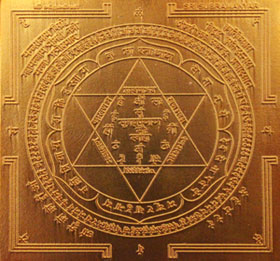


Left: Astronomical Map of the Earth (A.M.E). Middle: This is Indus emblem that evolved prior to Mahabharata War era of 3115 BC, and this emblem also described in the Bhagavad Gita, chapter 08, verses 24 and 25. Right: This is Not a Jewish "Star of David" as popularly believed to be; however, this is an Indus sacred emblem, which is depicted on many of Hindu temples' main door; also known as "Cosmic Dance", better known as the Astronomical Map of the Earth (A.M.E), which represents the four seasons; one form of ancient astronomy of ancient Bharata. Tropic of Cancer: June 21st , Equator: March 21st and Tropic of Capricorn: December 21st .
*** The Modern Scientists Vs Maha-Rishis of ancient Bharata: MahaRishis were divine scientists who invented numerous scientific theories.
A
ncient Mathematicians of Bharata
Baudhayana : (approximately 800 BC), the Indus mathematician who laid down rules of measurement in his masterpiece
Sulva Sutra, which also deals with irrational numbers.
Apastambha : (second century BC), an Indus mathematician who experimented with equations to design sacrificial altars.
Bhaskara: (born 114 AD), the Indus mathematician is the father of modern Calculus.
Aryabhatta (476-520 AD), the famous Indus mathematician and astronomer of Pataliputra. The first indigenous Bharatiya satellite is named after him.
Brahmagupta: (598 AD.- 660 AD), the Indus mathematician who worked with indeterminate equations (
Varga Prakriti).
Medhatithi: (sixth century AD), the Indus Mathematician who introduced the concept of Logarithmic, the
powers of 10 and was able to calculate very large numbers precisely.
Neelakantha: (1444-1545 AD), the Indus mathematician who devised the first known approximation of circular constant, popularly known as *
PI*.
Ramanujan Srinivasa: ( (1887-1920), the Indus mathematician from the Madras region of Tamale/Tamil Nadu, and he became a great modern mathematician, even though he was denied formal education in his early life. His gifted subjects were universal infinite series, number theory, and theta function. He was invited to Oxford University to solve his mathematical riddles; however, some of his mathematical works remain unsolved by the modern day mathematicians. Albert Einstein after understanding Ramanujan's infinite series, he tried to establish Theory of Relativities, which he couldn't prove it.
* 01. Baudhayana 800BC, * 02. Manava, 750 BC, * 03. Apastamba 600BC, * 04. Panini, 520 BC, * 05. Katyayana, 200 BC * 06. Yavanesvara, 120 AD * 07. Aryabhata I, 476 AD,
* 08. Yativrsabha, 500 AD * 09. Varahamihira, 505 AD * 10. Brahmagupta, 598 AD * 11. Bhaskara I, 600 AD * 12. Lalla, 720 AD * 13. Govindasvami, 800 AD * 14. Mahavira, 800 AD
* 15. Prthudakasvami, 830 AD * 16. Sankara, 840 AD * 17. Sridhara, 870 AD * 18. Aryabhata II, 920 AD * 19. Vijayanandi, 940 AD * 20. Sripati, 1019 AD * 21. Brahmadeva, 1060 AD
* 22. Bhaskara II, 1114 AD * 23. Mahendra Suri, 1340 AD * 24. Narayana, 1340 AD * 25. Madhava, 1350 AD * 26. Paramesvara, 1370 AD * 27. Nilakantha, 1444 AD
* 28. Jyesthadeva, 1500 AD * 29. Kamalakara, 1616 AD * 30. Jagannatha, 1690 AD
Ancient Bharata's Famous Universities:
Around 2150 BC during the Egyptian Civil War for 150-years, northern African mass migration into Bharata have begun, which continued throughout the 1200 AD. Slowly demographic of Bharata was changed, assimilation though out the subcontinent what we see today. In the past two thousand three hundred years, numerous foreign invasions, once a highly civilized and advanced divine nation Bharata was slowly decimated, First by Greeks in 327 BC then Greeks from Persia and other Central Asians later years numerous Islamic invasions from Central Asia, some Europeans and finally the British domination. Since the Indus Valley, Mohenjo-Daro, and Harappan civilization about 9,000 years ago, the ancient Bharata was advanced in science, astronomy, cosmology and mathematics. The world's First university was established in 550 BC at Taxila, when the rest of the world was under the Dark Ages. In 427 AD, the world's Second largest University Nalanda was established near Bihar, Eastern Bharata. Its library had over nine million books, and in 1197 AD Islamic invader Bakhtiyar Khilji and his soldiers burnt it, which took six-months. The great mathematicians like Baudhayana (800 BC), Manava (750 BC), Apastamba (600 BC), Panini (520 BC), Katyayana (200 BC), Yavanesvara (120 AD), Aryabhata (476 AD), and many more had reshaped Bharata to the highest level, where Varanasi was the First knowledge capital of the world, with many other educational institutions like the Odantapuri University at Somapura, Bihar (550-1040 AD) by Rajah Dharmapala of Pal dynasty. Jagaddala University was established in 1120 AD in west Bengal. Somapura University was established in 820 AD and stood for 750 years. Vikramaśīla University was established by King Dharmapala dynasty (783-1040 AD); Bakhtiyar Khilji destroyed it in 1200 AD. Also established were Valabhi University in Gujarat (712 AD), Varanasi University in Utter Pradesh (750 AD), Kanchipuram University in Tamale Nadu, Sanskrit Collge of Visaladeva, Puspagiri in Orissa (600 –1090 AD), Manyakheta in Karnataka (880 AD - ), Sharada Peeth in Kashmir (800 AD - ), Mithila, Vardhamama, and Pakshadhara Universities. In 1260 AD Rajah Gangesa Upadhyaya founded School of Navya-Nyāya, or Neo-Logical darsana of ancient Bharatiya logic and philosophy. Tattva Chinatmani was a work of a million pages, written over the course of 300 years, which was burnt by the Islamic invaders, and there were twenty elite schools also established. During the Islamic invasions most of these advanced colleges were destroyed, and highly skilled mathematicians and astronomers were killed. In addition, Hindus built a few hundred highly artistic temples across Bharata, and in Asia, to name a few, the red stone temple city complex of Vijaya Nagara, the thousand-pillar Meenakshi temple at Madurai. One of the largest Indus-Cambodian temple complex in the world (400-square-miles complex), the 1532-pillar Vishnu temple complex also known as Angkor Wat in Cambodia, and the Prambanan Hindu temple complex in Central Java, Indonesia. These two temples built to emulate the five highest mountains of the world including Mount Meru. The last 950 years of brutal Islamic rule and the British Christian occupation have erased the ancient knowledge of Bharata forever, killing the master mathematicians, cosmologists and astronomers. The barbaric British race completely brainwashed once highly advanced ancient Bharatians, and the vast majority of them fell into the trap of British education systems, shunning advanced ancient Bharatian science, astronomy, cosmology, arts, and mathematics, which completely vanished during the Islamic, Portuguese, Dutch, French, and British dominations. The vast majority of Bharatians
(Hindus, Jains, Muslims, Sikhs, and Christians) , Buddhists, Pakistanis, Bangladeshis, Nepali and Sri Lankan citizens of the 2000's are completely ignorant of ancient Bharata's true ancient histories, mathematics, science, astronomy, cosmology, and Samskritam studies, especially Bharatians who are living in foreign countries such as England, Australia, Canada, the United States, Trinidad, Guyana, Mauritius, Fiji, and South Africa. Those emigrants do not have any knowledge of ancient Bharata's great achievements and have become robotic slaves of western people's ideology, which was stolen from the Universities of Bharata and Temples by the Muslims, Portuguese, French, Dutch, Germans, and the British. Until 1350 AD these barbaric common Europeans did not know how to read or write (except the Romans, around 800 BC and the Greeks, around 650 BC, who composed their languages from Indus Brāhmī Scripts) . Once ancient Bharata flourished as the richest nation on the Earth, Islam and British deliberately and systematically destroyed it, and portrayed Bharatians as poor famished people to the rest of the worldly population. The 1900's robotic slaves of Bharatians, especially women changed their societies. (Vedic: "women are pillars of civilizations" and they make changes in any society) . The biggest mistake was the wounded Bharata's adoption of British political and educational systems that was officially imposed on August 15, 1947, as part of the independence agreements from the British crown, which shut the door for ancient Bharata's science, astronomy, cosmology and mathematics forever. The Modern-day divided Bharata still has not yet healed as an independent nation; however, Bharata's wheel of knowledge is spinning faster back towards original place. The Islamic, Portuguese, Spaniards, French, Dutch, British, and German people are the root cause of every problems that we are facing around the world today; wherever the Europeans invaded, they have killed animals to the brink of extinction, deforested billions of acres for timber, chemically polluted the river waters, and killed hundreds of millions of indigenous people around the world for their pleasure. (The numerous Islamic and Christian invasions are the biggest lesson to the divided ancient Indus Nation Bharata; for Warriors, Rajah, Maharajahs, Brahmana priests and common people) . In this modern world positive changes among Hindus is inevitable, only if they follow the core principle of Shanatana Dharma, understanding majority of Indus scriptures and ancient histories of Bharata. It is wise to learn Samskritam, not Hindi (Arwadi - an African dialect) and English dialect, and modern-day Bharatiya schools should teach their children about ancient Bharata's science, mathematics, astronomy, cosmology, histories and Indus scriptures; mainly Vedas, Upanisdhs and MahaBharata. It is wise for all modern Indus Bharatians to read all these ancient Indus Scriptures including understanding the principles of Bhagavad Gita, which are the important verses from Vedas and Upanisdhs.


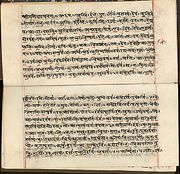

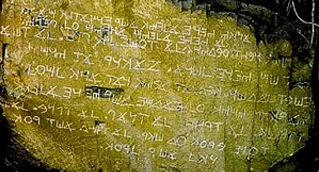
Left: Brāhmī Scripts, BharataRarsba 5,200 BC, are the oldest members of the Brahmic family of alphabets. On the Right: the indigenous people of America found this stone inscription, similar to Brāhmī Scripts. The Indo-European, Greek, Latium/Latin, and Indo-Persian languages evolved from ancient Samskritam, specifically Brāhmī Scripts, and these scripts were inscribed on the Ashoka pillars across ancient Bharata, Central Asian regions, and Middle East. The Romans formed their Latium scripts from the ancient Bharata's earlier Samskritam Brāhmī Scripts around 850 BC, and the Classical Greek was formed their scripts around 650 BC. Ancient Bharata's Brāhmī Scripts were brought to ancient Roma around 850 BC by a group of immigrants from the Central Asian minor region. Latin begins as a local tongue of a small territory on the Tiber River, known as Latium. It soon spreads over a larger part of capital Roma and eventually the Roma Empire. The Latin of Roma becomes the literary model of the new Roma Empire. The golden age of ancient literary Latin occurs between 80 BC-14 AD. The most famous authors of that time were Livy, Cicero, Catullus, Vergil, Horace, Caesar, and Ovid. The Latium is known as another time of glory that ended in the middle of the second century AD with the authors like Tacitus, Juvenal, Pliny the Younger, and Suetonius. The golden age of the Latin period (200 AD-600 AD) coincides with the decline of the Roma Empire. Once Latium, later Latin was the cradles of early Roma/Roman language including spoken Greek in their Empire. Rome is called Roma in Latin during their Empire. Once ancient Indus Brāhmī Scripts were commonly used in the Middle East around First Century BC. Brāhmī Scripts was a spiritual language also known as the ancient Sanskrit of Bharata. Nakaal was a spiritual language of the continent ManU in the Pacific Ocean. Once the Nakaal language was spoke around the world like the English today. Note: Old Roman Cursive known as Latium, not modern Latin of 200-600 AD originally derived from the Indus Brāhmī Scripts. All the European alphabets were derived from Latin scripts except for Scandinavians, later years they also adopted Latin scripts. Magadhi Prakrit, Gupta and Gujarati scripts also adopted Brāhmī Scripts. Indigenous Cree, Cherokees and others also formed their languages using Nakaal and some form of Brāhmī Scripts. Note: the old Greek was Native to the southern Balkans, which has the longest documented history of any Indo-European language families, spanning thirty centuries of written records are available. About 1,000 BC Bulgarians First composed their language adopting Indus Brāhmī Scripts. In the modern era African nation Ethiopia still uses ancient Indus Brāhmī Scripts in their written language.
The Origin of ATOM: The earliest references to the concept of atoms date back to ancient Bharata around 600 BCE, and it was originally proposed by a sage Kanada (Kana-bhuk, literally, atom-eater) an ancient Hindu philosopher. The Nyaya and Vaisheshika schools developed elaborate theories of how atoms combined into more complex objects (first in pairs, then trios of pairs: example modern words Proton, Electron and Neutron). The references to atoms in Greece emerged, a century later by Leucippus, and Democritus, systematized his views. Around 450 BCE, Democritus coined the term atomos (for atoms), which meant "uncuttable." Though both the ancient Bharata and Greek concepts of the atom were based purely on philosophy; however, modern science has retained the name coined by Democritus. The Vaisheshika, (Vaiśes.ika in Samskritam) is one of the six Indus schools of philosophy (orthodox Vedic systems) of Bharata. Historically, it has been closely associated with the Hindu school of logic, Nyaya. Vaisesika espouses a form of atomism and postulates that all objects in the physical universe are reducible to a finite number of Ahtoms.
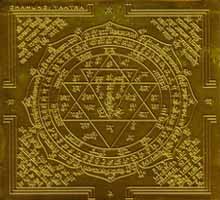
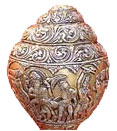



1. On the Left: ancient Bharatiya Calendar. 2. On the Middle: ancient Maya/Aztecs Calendar. 3. Right: One of the ancient Inca's many calendar. Ancient Bharata's Calendar: The Earth takes 365-days to orbit around the Sun because earth is presently tilted 23.26 degrees. During the last Vedic period, say about 5,200 years ago, only 360-days a year when Earth was tilted at 22 degrees: what has changed to have an extra Five day? The Incas stated the extra Five days as bad days. The Five days increase due to Earth’s orbital position moved to a new position in space because of the Quantum Shift - such action flooded the earth killing millions. Moon has two orbital rotations around the earth. So, the Moon takes an average of 28.10 days to orbit around the Earth. The seven days a week named after Sun, Moon, and five planets of our solar system. The seven-day per week is multiplied by Four corners of the Earth results in 28 days. The thirteen months multiplied by twenty-eight days resulting 364 days, it means one month has 29 days. The Maya Solar Calendar Haab had twenty days that is multiplied by eighteen months results 360 days, which is the original Pandava calendar plus Five nameless days known as dangerous days because of the worldwide flooding. Because of the Quantum Shift, the earth's orbital position has changed in space also earth tilted from 22 to 23.26 degrees and an extra Five days were added in a year. What is Quantum Shift? THINK like a Fox! It is all about Sun's diameter increased from 108 to 109 and presently at 110. Once the Inca's calendar had twelve months that is multiplied by thirty days resulting 360 days and they also had Four Yugas; 1. Vari Vira Cocha Runa, 2. Vari Runa, 3. Purun Runa, 4. Auca Runa during the Vedic BharataRarsba period.

Universe
Power
of Ancient SamskritamAccording to the Puranas, Brahma was self-evolved from a Lotus flower where he born from the navel of Vishnu: in the scientific point of view this story is incorrect because Vedic deities Brahma, Vishnu and Shiva are within the nucleus of E/Ishwaram, Only One Supreme God, not a separate entity. The Indus scientific version: the Brahmanda [Cosmos] was self-created with an atomic super explosion (Sphota) with a divine voice of OM, which is the AhdiDevam; the lord of beginning. The creation divine voice of the cosmic Brahmanda is OM. Indus confused story: thus comes one of his names Nabhija (born from the navel). From a golden egg (Atom), the self-creator Brahmanda was born as a Hiranyagarbha. The remaining materials of the golden egg (Atom) transformed into trillions of Agnis (stars), planets, asteroids, and comets within the Brahmanda OR Cosmos. The idol Trimurthi Ishwaram is traditionally depicted with Four heads, Four faces and Four arms and with each head where divine entity continually recites one of the Four Vedas. The Bhagavata Purana further states that Trimurthi Parameswaram/Ishwaram has more than Four heads, counting into millions of heads, perhaps it means millions of Galaxies where Ishwaram is the ruler of the Brahmanda [Cosmos], which is the combination of millions of galaxies.
The Brahmanda [Cosmos] with trillions of Agnis (Stars) were born with the atomic super self explosion with a divine voice of OM, which is the AhdiDevam. So, all the Indus ceremonies begin with OM. In the Bhagavad Gita chapter 10, verse 21 states that Vishnu created all the Agnis to sustain life in the Brahmanda. Note: Vedic scripture states Only One supreme deity Ishwaram/Parameswaram: Brahma, Vishnu and Shiva were formed within the nucleus of Ishwaram. This is similar to from the God particle Atom: Proton, Neutron and Electron are within the nucleus. So, here Proton is Brahma, Neutron is Vishnu and Electron is Shiva and they all have the same functionalities. So, the above illustration-figure is inaccurate because the main story of Brahma and Vishnu: from Vishnu's naval Brahma was born but based on Vedas such process is untrue. Indus: Brahma is the creator and in the scientific view Proton creates every thing on the earth, perhaps on the other planets also. AhdiDevam is the Lord of Beginning by the atomic super self-explosion creating the Brahmanda. Contradiction between Brahma and AhdiDevam and Bhagavad Gita chapter 10, verse 21. It is safe to say Brahma creates every thing on the earth similar to Proton. The action of AhdiDevam is the modern day Big Bang Theory: once it was recited by the ancient BrahmRishis, not modern scientists. AhdiDevam is the "Surya Koti Samaprabha" it means Atomic super self-explosion brilliance as equal to Ten Million Suns, not Ghanesha because during the puja priests perhaps unknowingly recites Vedic mantra. The ancient divine ruler Shiva might have had a son named Ghanesha during the Satya Yuga, which is popularly believed across Bharata. The Egyptian Sphinx is Pharaoh's head and Lion's body, which is a NaraShimma avatara and in Bharata Ghanesha has Elephant's head and Human body: also Sphinx. It means animals appeared First on the earth and the humans came later: this is an ancient scientific meaning. The Ghanesha festival is respects animals and humans, and Ghanesha is not a god. Both are Sphinxes and they represent Animals and Humans on the earth. So, worshiping Sphinx is similar to worshiping Humans and Animals. So, it is wise to worship AhdiDevam, which is the Ishwaram/Parameswaram: Only One Vedic supreme deity. Note: Hanuman where Hanu means African Ape and Man means Manusya (Human). From African Ape to human transformation has taken place in Africa say approximately over 3 million-years ago. It is unwise to worship an idol Hanuman OR building a temple for an African Ape. Hanuman was a realistic ancient African human evolution theory also in the modern times.
Surya/Sun controls our solar system providing energies to all the living beings sustain life on the earth. In the past 4,000-years the Brahman/Seers priests made numerous stories, and they hardly told the truth to the Bharatians because in the subcontinent of Bharata over ninety percent of the subjects are African origin - assimilation with the indigenous Hindus that changed the demographic of Bharata. African mass migration began from the regions of North-Eastern Africa around 2,150 BC throughout the years of 1,200 AD. The BrahmaRishis and MahaRishis recited the truth, but the clever Brahman and Seers did not tell the truth to the ancient people for their advantages that led to various misunderstanding in ancient Bharata. Eventually vast majority of the African origin people who were not True Hindus, because of their caste status imposed on them, they became non-believers eventually converting into Buddhism, Islam, and Christianity disrespecting the foundation of Shanathana Dharma's core principles of Vedic beliefs. In this modern era, because of the Islamic and Christian influences numerous untrustworthiness and suspiciousness developed among the people of Bharatian subcontinent what we see today. Subcontinent is divided in many forms and at this time the reunification is impossible. From Indus scriptures, especially from Vedas, Upanisdhs, Manusmriti, Bhavishya Puranas, and others, the Old Testament, Bible and Koran were composed, not individual creation OR any entity as they claimed to be! When the Islamic and Christians reads their scriptures they actually indirectly reading the Vedic Indus scriptures.


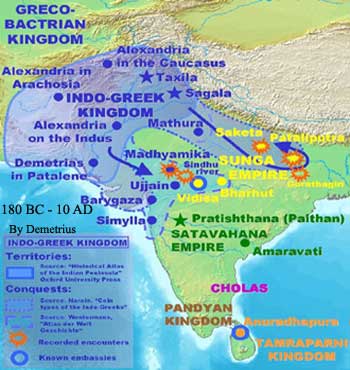
New Greek invasion from Persia formed new Indo-Greek Empire in the north-western Bharata, and the Greek kings in their reign from 180 BC through 10 AD have done enormous contribution to the Hindu societies and Buddhism. A few Hindu temples have some stone statues that were dedicated to Greek statesmen. In the 190-years Greek rulers have imported Indus pagan deity system to their homeland Greece, which is flouring even to this day. Example: In Bharata Vedic Indra is the king of gods also god of Rain & Thunder. In Greece Zeus is the king of gods also god of Rain & Thunder. One Greek king built a Buddhist Stupa in Sri Lanka/Lenke. In the subsequent years from southern Asia Minor Scythians invaded western Bharata forming a new Indo-Scythian Empire, where some Scythians rulers also did enormous contribution to the Hindu societies and Buddhism in their reign from 110 BC through 395 AD. Eventually, Scythians accepted Indus Vedic traditions, customs and culture. Around 700 AD they formed a Rajasthani kingdom better known as Rajputs.
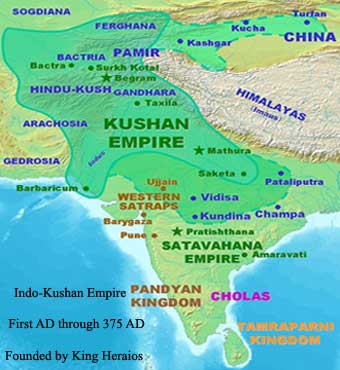

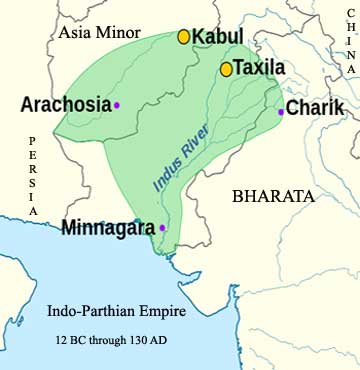
The Kushan has begun their journey from Asia Minor into Bharata and they established their Indo-Kushan Empire. The Kushan First king was Heraios and his reign was around First AD through 30 AD and the Kushans ruled Western Bharata until 375 AD and they also have done some good contribution to the Hindu societies and Buddhism. The Indo-Parthian (Persian) Empire rooted from 12 BC through 130 AD ruling some parts of Western Bharata. Around 1000 AD, the Central Asian Islamic invaders numerous times invaded north-Western Bharata dismantling twenty Indus schools, especially famous Nalanda Universities in 1197 AD and looted numerous Hindu temples for diamonds, gold and silvers. The various Islamic rulers have changed the demographic and histories of ancient Bharata, decimating Hindu tradition and culture forever. The British intervenes stopped the further expansion of Islamic Empire in the Bharatian soil and that was one of the huge contribution to the Hindu societies. Say this could be a divine's plan. The British have done enormous contribution reshaping Bharata developing housing complexes including Schools, Roads, Bridges, Survey, eliminating many superstitious beliefs, introducing Railways, Telegraphy-Telephones, Automobiles, Vimana (modern Airplane), and some British became Sanskrit scholars, and in the middle of 1600 they have translated over one-million versus of Indus Scriptures into English for the world to appreciate and they especially permitted education for all the societies. That was a game changer for Bharatians. Such education system was't provided under the Rajahs and Maharajahs' era for their subjects except to elites and Brahmins only. African origin and assimilated Indus commoners, based on the caste system, were forbidden to enter any education institution and temple complexes.
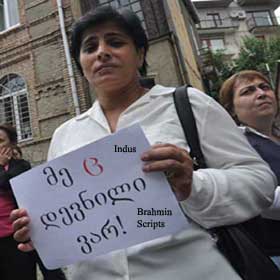
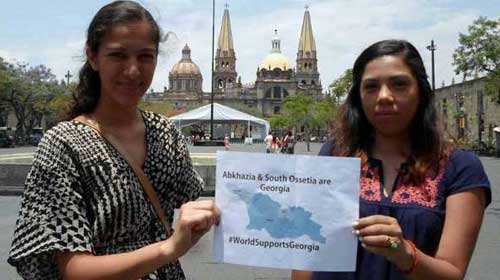
Ancient human migration from Bharata to the Central Asia can be traced by their dialects and DNA. Throughout world, the human migrations were for over two millions of years.
W
ho Discovered AmericaAnswer: none other than Indigenous people of the entire ancient American continent who migrated from various parts of the world around 60,000 years ago, especially from one of the ancient continent ManU in the Pacific Sagara (Ocean), once stretched over 5,000 miles long from North-West to South-East almost parallel to the modern day Central and Southern America and approximately 3,000 miles wide from the West to East - remaining is the present day chains of Hawaiian Islands in the Pacific . The Inhabitants of ancient continent ManU were one of the most intellectual societies of the ancient world. About 74,000-years ago ancient continent ManU began plummeted into the ocean because the series of earth quake activities in that region (rings of Fire) and its inhabitants moved to the present day Central and Southern American regions and other Pacific Ocean 40,000 Islands, also to the West such as present day Indonesian and Philippine Islands, East Asian regions, Bharata, China, Korea and Japan. The indigenous people of the ancient Central and Southern America, Indonesian and Philippine Islands, China Eastern Asian countries, Korea and Japan were ONE (about six-million-years old) ancient human race based on their facial features and DNAs. Ancient Sri Lenke/Lankan inhabitants reached the ancient American southern continent about 11,000 years ago and the ancient Bharatians reached Patala Loka/Middle America and West Coast about 7,000 years ago. The indigenous Toltecs were from greater Central Asian region Tula and they reached American west around 200 BC and the Aztecs were from Sri Lenke/Lankan origin and their traces still intact in the Middle America. Example: Xi Lenke/ Pa Lenke in the present day Mexico also many more evidence. Note: Ancient humans lived in the continent America for millions of years - Trans-Pacific human migration. Columbus discovered America is a joke - popularized by the Christian Europeans who genocide nearly hundred million indigenous Americans.
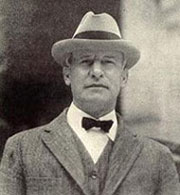
Ambassador Miles Poindexter states in his book, The Ayar-Incas, the word 'Ayar' means the "Aryan people, who sailed to the ancient American continent by the island chains of Polynesia." The very name of the boat in ancient Mexico is a southern Bharatiya Tamale/Tamil word, 'Catamaran' in the Nahuatl dialect of Middle America and also the dialect of Aztec Empire. (Source: "The Ayar-Incas," by Miles Poindexter, published by Horace Liveright, New York, volumes 1-2.1930). The ancient Hindus were mighty navigators and pioneers of cultures for centuries before Columbus was born. They established their cultural empires in Java, Bali, and Sumatra (Swarnadwīpa 'Island of Gold') in Indonesia, Cambodia, Vietnam, Burma, Thailand, Malaysia, Borneo, and Philippines, where they ruled until the fifteenth century.
The emigrant races of the ancient Bengal, Tamale region and other Bharatians voyaged through Southeast Asia and over the southern Pacific Ocean to ancient America, importing their system of time measurement, their local gods, and their customs, including sporting games, dances, and ceremonies. They also carried a belief in the four Hindu Yugas (epochs or ages), the existence in ancient Middle America of the ancient Hindu Gurukala, a method of Indus education system, the Hindu Panchayat System, the bazaar economy, the Soma Yagna (Yagni sacrifice), and the worship of Indra, the god of Rain & Thunder, Indus Trinity, and some ancient Indus gods. Both the Hindus and ancient Americans used similar items in their worship rituals. Both continents maintained the concept of Four Yugas known as cosmological seasons, extending over tens of thousands of years, and conceived of twelve constellations with reference to the Sun. As indicated by the Incas, Toltec and Aztecs, the Sun calendar bears the imprint of ancient Hindu culture. Siyaj Chan K'awiil of Indus origin founded a Kawiil dynasty at Tikal in 307 AD. Balaj Chan K'awiil was crowned in 635 AD at Tikal, and he founded a new rival kingdom at Dos Pilas in 648 AD. The Kawiil dynasty reigned for 702 years in the regions of Tikal, Kalakmul, Dos Pilas, and Copan.
Mr. Miles Poindexter, a former ambassador of the United States to Mexico, writes in his two-volume treatise of the 1930s, "The Ayar-Incas," echoed the Maya civilization is "unquestionably linked to ancient Hindus." He proposed that the primitive Aryan word refers to 'various tribal people, who came to ancient America by the island chains of Polynesia,' over the southern Pacific Ocean. Eastern Asian origin Rama indigenous people who live in the Mosquito Coast of Nicaragua, some speaking a Rama dialect, perhaps reached ancient Middle America around 5,200 years ago. Ambassador Poindexter provides a list of words in the Inca's Quichua dialect and their analogous forms in Samskritam on page-3 of his treatise. Mexican researchers claim that the Cuicateco/Nahuatl dialect of Ōlmēcatl-Xicalanca and Aztecs were derived partly from one of the ancient Indus Samskritam. The Mexicans still retain a name, 'Tamale/Tamal' for one of their special festival food items. The Chinampas de Gorostiza and Chinampas of Xochimilco are regions in Mexico. The Aztecs developed floating stationary vegetable gardens on the lakes, a form of agriculture used to grow beans, squash, tomatoes, chilies, herbs, and flowers that is also called Chinampas, which is of southern East Asian origin. Indus origin, Siyaj Chan K'awiil founded a Kawiil dynasty at Tikal, Patala Loka in 307 AD. His great grandson Balaj Chan K'awiil was crowned in 635 AD at Tikal, and he founded a new rival kingdom at Dos Pilas in 648 AD. The Kawiil dynasty reigned for 702 years in the regions of Tikal, Kalakmul, Dos Pilas, Palenque, (Pa'Lenke) and Copan. Sage of Bharata BalanKanche voyaged to Middle America between the years 800-850 AD, prior to the construction of four season Astronomical Map of the Earth Kukulkan pyramid in the Yucatán peninsula. Maya meditation cave BalanKanche is situated next to the Kukulkan pyramid complex in the Yucatan region. A series of Indus sages from Bharata voyaged to ancient Middle America have taken place from 500 BC through 1450 AD, and the last Indus sage was Chinampa during the Aztec Empire under the Emperor Montezuma I. The indigenous Ōlmēcatl/Olmecs lived around the region Xilanca/Xicalanca (Xi Lenke, in Maya Xi = Sri) of Mexico, Spaniards called them Olmecs. They are known as ethnicity of the Ōlmēcatl-Xicalanca who also lived around the regions of Cholōllān (Nahuatl) and Vercruz. Cacaxtla was the capital of region that once inhabited by the Olmeca-Xicalanca people and they were the ancient civilization of Middle America. Presently Xilanca/Xicalanca is known as Xicalango at Vercruz and Tabasco regions of Mexico. When Columbus reached the Guanahani Island on October 12, 1492 with the Spanish conquistador, Xi Lenke origin Ōlmēcatl-Xicalanca indigenous people were living in the today's Bahamas Archipelago Islands, Hispaniola, Guyanese-Venezuelan jungles, Amapa, Brazil and Pa' Lenke's surrounding regions of Mexico, and they have reached ancient America about11,000 years ago. The legend has it; the ancient Ōlmēcatl/Olmecs-Xilanca giants partly built the pyramid of Cholōllān, also known as Tlachihualtepetl (Nahuatl for "artificial mountain"), which is located in Cholōllān of Mexico. Nahuatl was the primary dialect of Ōlmēcatl-Xilanca that spread across the ancient Middle America. The Toltec and Aztecs empire subjects also spoke Nahuatl and they used Nakaal scripts.

This article demonstrates during the ancient era, many nations and islanders voyaged between the continents over the southern mighty Pacific Ocean to reach the RapaNui Island, but their final destination was Southern and Middle ancient America: Polynesian Islanders, Hawaiians, Sri Lankans, Annasazis, Tamale, Indus Rishis, Indus elite royal families, Southeast Asians, Siberians, Central Asians, Mongolians, Kurus, Tulans, and Others.
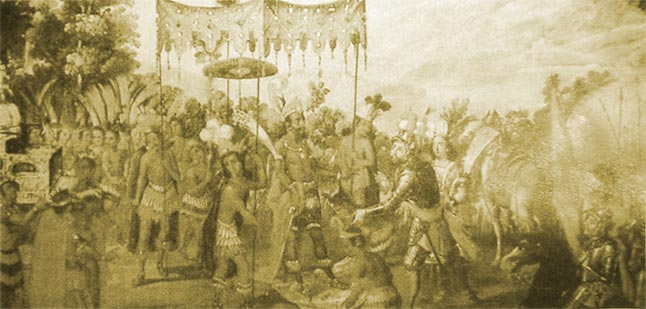
p class=MsoNormal style='text-align:justify'>At Iztapalapa /Ichapalapa Aztecs, Mexico, the meeting between Spaniard Hernándo Cortés and the dark skinned Aztec Emperor Moctezuma II (Motecuhzoma Xocoyotzin, spelled Montezuma) in November 1519 AD is depicted in this 16th century Spanish painting, located at the British Embassy, Mexico City. Unfortunately, the Aztecs indigenous people did not survive their cultural exchange with the Spaniards due to smallpox and many wars. The Conquistador's Maya book burning took place at Mani by notorious Bishop Diego de Landa, and killing the Aztecs, Tlaxcala, Cholula Ichpa-Maya and Naga-Maya civilians while unsuccessfully converting them into Christianity left very little trace of their noble ancient advanced knowledge and civilization. In this Spanish Mural the last Aztec Emperor resembles a Dravidian Olmecs Xicalancan race rather than the mixed indigenous people of the Central American regions. The doctrines of Hindu Yugas were assimilated into Maya at Copan, Priyadarsh Nagara, Tikal, and Palenque including Olmecs, Toltecs, Aztecs, Incas, Zuni, Navajo and Hopi indigenous people of ancient America. Izapa is Ichpa. (Z for Ch)
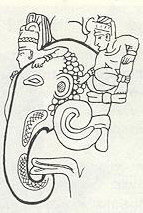

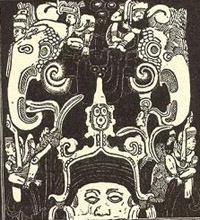

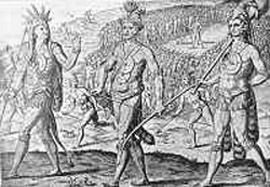
Was Elephant existed in the Middle America? The Elephant motif exists in Maya sculpture, which has significant meaning, even though the elephants weren't native to ancient America. The Maya "long nosed god" is valued by those who favor the hypothesis of direct ancient Bharatian Empire cultural influence among Maya. A mythological scene has been carved in this stela depicting the architectural and artistic maturity of the Maya ruler along with a beautiful image of a deity with the eight hands of Ashtabhuja. 'Aztec' or Ashtak means eight. Right: Maya stela 3 on the temples at Copan, and Priyadarsh Nagara, it appears that the Maya Emperor received the arriving Bharatiya leaders while his large armies stood behind.
Donald A. Mackenzie (pages: 28-35): Discusses "the diffusion of ancient Hindus' religion mainly to the Maya, Toltecs, and Aztecs," empires in "The Diffusion of a Great Religious System from ancient Bharata to Mexico." Scholar Paul Kirchhoff (1900-1972), a German anthropologist from the University of Frankfurt, had suggested that it is not simply a question of miscellaneous influences wandering from one country to another; however, China, Bharata, Java, Bali, Incas, Maya, and the Aztecs of Mexico actually share a common religious and astronomical system.
The curator of the National Museum of Mexico writes; "The irreproachable technique of their relief's, the sumptuous headdress and ostentatious on high, the system of construction, all speak of ancient Bharata and southeastern countries of Asia." Durant's Manuscript "Historia de la Indias," provides detailed illustration of the costumes and cotton clothing worn by the Maya, Toltec, Tlaxcala, and Aztec nobility. Because cotton plants grew wildly in Bharata and Sri Lankan forests, cotton trees were also planted in Central and South America and it became sacred tree for Maya.
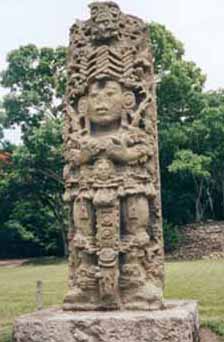

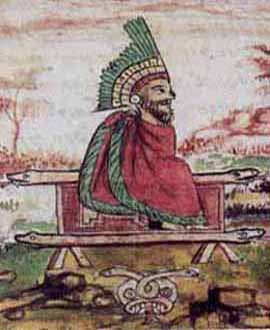

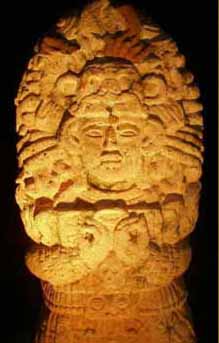
Left: Maya Emperor/Priest stela, hand finger position describes: OM meditation. Middle: Quetzalcohuātl was a serpent deity for Olmecs, Toltecs, Tlaxcalan, Cholōllān and Aztecs rulers. Similarly for Maya, a serpent deity was Kukulkan who portrayed him floating on a 'Raft of Serpents' to emulate divine Vishnu on the Shesha. Olmecs, Maya, Toltecs and Aztecs indigenous rulers have depicted above image on their Maya temple wall. Maya honored him as sage Ah Ichpa or Balan Kanche around 800 AD where Balan-Kanche is a sacred site for Maya. For the past 5,200 years, a series of Indus sages have arrived in the Middle ancient America under Olmecs, Maya, Toltecs, Aztecs and they have crowned him as their Emperor! Right: this stela is not made by Maya, but found in the region of Tulum, southern Mexico, where once Maya Empire flourished.

Only one evidence is found by the National Geography, which shows the old Nakaal script was used during the Toltecs/Aztecs eras. Once Nakaal scripts were widely used across ancient American among indigenous people, Hawaiian, Pacific Islanders and Far East countries. The Toltecs, and Aztecs Natives also used Pictographs; however, the spoken dialect was Nahuatl, not written scripts. March 2008: the National Geographic (N.G): found above Toltecs or Aztecs era writing in Nakaal script in Mexico. Nakaal scripts are also inscribed inside the Vishnu temple complex at Angkor-wat, Cambodia, and the Nakaal script were found in Thailand*, Burma*, Vietnam*, Malaysia*, Indonesia*.
Today there are over 65 indigenous tribes in the modern Mexico and they have 65 tribal official dialects as languages, and there are 22 indigenous tribes in the modern Guatemala, Central America and they have 22 tribal official dialects as languages. The Indigenous Aztecs differs with Mexica tribes and the modern country named Mexico, which was derived from that word Mexica!
The Indus scriptures The Indus scriptures have numerous facts about ancient America as Patala Loka, especially for the Middle America. In Samskritam Patala Loka means 'other side of the earth at 180 degree from Bharata on the Tropic Cancer, which passes through southern Mexico. According to the Indus scriptures, an eagle (ancient airplane-Vimana) named Garuda transported thousands of Nagas to Pushkara. Legendary tribe Tohono O'odhams of Arizona describes such a sky-ship as 'Nah-Big,' a term derived from ancient Samskritam 'Nag-Bhaga' or 'Flying Snake.' That was some kind of flying airplane of ancient Bharata. Google earth reveals Astronomic Map of the Earth (A.M.E) emblem on the desert of Nevada, and each of its lines are 360 feet long. The footprint of Astronomic Map of the Earth (A.M.E) does validate ancient Bharata's Emperor Priyavarta rule in the western America about 7,200 years ago. In 240 BC Emperor Ashoka sent Buddhist missionary to Southern and Middle America, it stated on the book "Incas", written by the famous Peruvian archeologist Walter Alva. The famous ancient port is Khetumala stated in the Indus Lotus World Map, and Ichpa of Maya Empire. The trades between Patala Loka and ancient Bharata continued for thousands of years, and a new Tamale/Tamal people's trades began as stated by Ambassador Miles Poindexter around 800 AD. From 1492 AD Spaniards systematically destroyed ancient Bharata's culture, tradition and customs in ancient Middle and Southern America, (Patala Loka) forever. Note: The Bharataria or Barataria Bay is named after a part of the Gulf of Mexico in the southeastern Louisiana. When and who might have named Barataria Bay is the big question.
Ancient Bharatiya historians called the distant land Patala Loka, where the Patala king ruled or Pakala, king for Maya people. The ancient Bharatians named North America as Pushkara, and Southern islands as Kusa Dvipa. Southern ancient America resembled an eagle's beak with outstretched wings (over looking Brazilian Manu Forest and Manu River from the Inca land in the today' country Peru) and Central America, as its tail, named Vishnu Kranta. Around the world, smarter people are learning Samskritam, except Hindus and also it is wise to understand the scientific meanings of Vedas, Cosmology, Astronomy, Upanishads, Puranas, and Mahabharata's War messages! Please note that Hindi and Urdu are unfit languages of Bharata, and Samskritam should be the national language of modern Bharata. All the Bharatians should rename their ancient country name Bharata, not British-India!
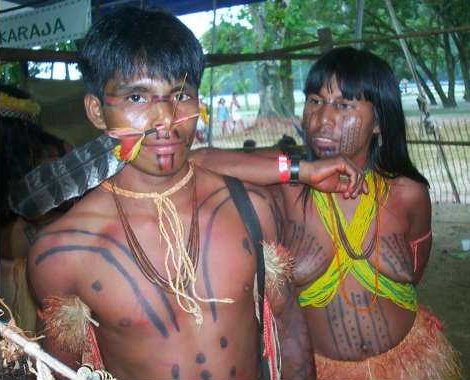
Heyerdahl's discoveries are detailed in his book: "The Maldives Mystery." One of the Brazilian indigenous people are Sri Lankan origin tribes, today they mainly live in the Northern Maranhao province of Brazil, on the coastal town of Amapa where equator pass through it. Ancient Sri Lankans also live on the Southern region of Manu (Amazon) River who reached ancient Southern America over 11,000 years ago and some are assimilated with the Portuguese invaders. The nuclear DNA has the life of span of 40,000 years. The Sri Lankans (Xicalanco, Xicalango town names in corrupted Spanish words is located in the Mexico) also reached the Middle America about 11,000 years ago. Heyerdahl's book is one of the best evidence of ancient Bharatian and Sri Lankan sea voyages through the chains islands of Polynesia on the Southern Pacific Ocean. In Brazil, numerous Sri Lankan tribal women were taken over by Portuguese settlers from 1600 AD and their children's physical and facial features resemble some modern-day Bharatians and Sri Lankans.
 Video 01: Assam Natives resembles Maya, Incans
Video 01: Assam Natives resembles Maya, Incans
 Video 02: Bharata to Modern Bharata.
Video 02: Bharata to Modern Bharata.
 Video 03: Bharatian Numerals - BBC
Video 03: Bharatian Numerals - BBC
 Video 04: Origins of civilization - BBC
Video 04: Origins of civilization - BBC
 Video 05: Bharatian Science - BBC
Video 05: Bharatian Science - BBC
 Video 06: Lost Treasures of Bharata - BBC
Video 06: Lost Treasures of Bharata - BBC
 Video 07: Golden Age of Bharata - BBC
Video 07: Golden Age of Bharata - BBC
 Video 08: Tamale/Tamil Cholan Empire - BBC
Video 08: Tamale/Tamil Cholan Empire - BBC
 Video 09: Vivekananda Speech at Chicago 1893
Video 09: Vivekananda Speech at Chicago 1893
 Video 10: Scientific Sanskrit Language
Video 10: Scientific Sanskrit Language
 Video 11: Scientific Verification of Vedas
Video 11: Scientific Verification of Vedas
 Video 12: Vishnu Temple - Angkor-Wat
Video 12: Vishnu Temple - Angkor-Wat
 Video 13: Scientific Dating of Angkor-Wat
Video 13: Scientific Dating of Angkor-Wat
 Video 14: Vishnu Temple - Angkor-Wat
Video 14: Vishnu Temple - Angkor-Wat
 Video 15: Indus: Vishnu Temple - Angkor-Wat
Video 15: Indus: Vishnu Temple - Angkor-Wat
 Video 16: Indus: Vishnu Temple
Video 16: Indus: Vishnu Temple
 Video 17: Vishnu Temple - Angkor-Wat
Video 17: Vishnu Temple - Angkor-Wat
 Video 18: Coral Castle - Mystery
Video 18: Coral Castle - Mystery
 Video 19: Ancient Persians Empire
Video 19: Ancient Persians Empire
 Video 20: Re-constructions Vishnu Temple - Angkor-Wat
Video 20: Re-constructions Vishnu Temple - Angkor-Wat
 Video 21: Jesus learnt Tantra Yoga in Tibet
Video 21: Jesus learnt Tantra Yoga in Tibet
 Video 22: Jesus went to Vedic school
Video 22: Jesus went to Vedic school
 Video 23: Jesus in Kashmir
Video 23: Jesus in Kashmir
 Video 24: Jesus in Kashmir
Video 24: Jesus in Kashmir
 Video 25: Jesus in Kashmir
Video 25: Jesus in Kashmir
 Video 26: Bible is Bull Shit
Video 26: Bible is Bull Shit
 Video 27: Bible is repulsive
Video 27: Bible is repulsive
 15: New Zealand's 1400 AD Tamale Bell
15: New Zealand's 1400 AD Tamale Bell
 Video 29: Aztecs Engineering
Video 29: Aztecs Engineering
 Video 30: Sri Lankan Ramayana
Video 30: Sri Lankan Ramayana
 Video 31: Vijaya Nagara
Video 31: Vijaya Nagara
 Video 32: Musical stone pillars
Video 32: Musical stone pillars
 Video 33: Mahabalipuram: Singing stone pillars
Video 33: Mahabalipuram: Singing stone pillars
 Video 34: Sphinx of Bharata
Video 34: Sphinx of Bharata
 Video 35: Chandra Bose Speech
Video 35: Chandra Bose Speech
 Video 36: Power of Samskritam
Video 36: Power of Samskritam
 Video 37: Pallava Empire, Mahabalipuram
Video 37: Pallava Empire, Mahabalipuram
 Video 38: Kanchepuram
Video 38: Kanchepuram
 55: 30% Tamale- Inca deities names
55: 30% Tamale- Inca deities names
 1: Economy of ancient Tamale
1: Economy of ancient Tamale
 2: Ancient Shipbuilding
2: Ancient Shipbuilding
 3: History of Southern Bharata
3: History of Southern Bharata
 4: Middle kingdoms of Bharata
4: Middle kingdoms of Bharata
 5: Buddhism in Cambodia
5: Buddhism in Cambodia
 6: Hinduism in Southeast Asia
6: Hinduism in Southeast Asia
 7: Ancient Bharatian mathematics
7: Ancient Bharatian mathematics
 8: History of Tamale Nadu
8: History of Tamale Nadu
 9: Ancient Tamale history
9: Ancient Tamale history
 10: Emperor Ashoka
10: Emperor Ashoka
 11: Chandragupta Maurya
11: Chandragupta Maurya
 12: Angkor-Wat: Vishnu Temple
12: Angkor-Wat: Vishnu Temple
 13: Champa (Vietnam)
13: Champa (Vietnam)
 Dr. Carl Sagan Video 1: Ancient Hindu Cosmology
Dr. Carl Sagan Video 1: Ancient Hindu Cosmology
 Carl Sagan, Steven Hawking, Arthur C. Clark Video 2 Cosmology
Carl Sagan, Steven Hawking, Arthur C. Clark Video 2 Cosmology
Earth's tilted axis takes 2,135.84 earth-years in an astrological sign and moves onto the next sign, and also goes backwards through the signs of the Zodiac. Since we are completing the Piscean cycle, earthly beings are ready to enter into the Aquarian cycle, for the next 2,135.84 years. We commonly refer to entering Aquarius as the "dawning of the Age of Aquarius." An arc is 5,126-years in the Earth's tilted axis in reference with a North Star. Indus 5,126-years multiplied by the Fifth North Star results Indus 25,630 earth-years. However, the modern astronomer concluded 25,772 earth-years for a revolution in the earth's tilted axis, a difference of 142 years adding to the Vedic cosmology. The earth takes 2,135.84 earth-years for each Zodiac sign, but this varies based on the modern finding of 25,772 earth-years. During the end of Dwapara Yuga a revolution of the earth's titled axis might have calculated 24,000 earth-years with the reference of North Star at that time. The MahaRishis might have calculated Indus Four Yuga's based on a titled axial revolution of the earth that was 24,000 earth-years at the end of the Dwapara Yuga. There is no such clear document is available to prove a true Yuga calculation. In the modern era Rishis (scientists) were enable to conclude the actual calculation of each Yuga cycles. Many Indus Yuga calculations were posted on the YouTube, and Wikipedia, those are totally inaccurate because Indus scriptures do not state any such true calculation! At present we have to take the modern 25,772 earth-years for a Earth's tilted axial revolution OR the Indus version is 25,630 earth-years. So, it seems Fifth North Star may not end in 2025 instead it may end in 2054 shifting onto a First new North Star in an astronomical cycle. For every 5,126 OR 5,155 earth-years a new North Star appears.
The
Great CycleThe Earth rotate on its titled axis while it is orbiting elliptically around the Sun at a speed of 66,670 miles-per-hour. The entire Solar system, especially the Sun travels at a velocity close to12.88 million miles-per-day elliptically around the spiral Milky Way Galaxy along with all the Zodiac star signs. This is a useful analogy because changes in overall states of consciousness are represented as "Seasons" for every 5,126 OR 5,155 earth-years through which the Solar system passes on its journey. At the end of every 5,126 OR 5,155 earth-years there may be a odd planet formation in the heaven where Sun and Moon on the left in reference to the earth and Mars, Mercury, Jupiter, Venus, Saturn on the right. The MahaRishis/Rishis named our weekdays based on the odd planetary positions: Sunday (Sun), Monday (Moon), Tuesday (Mars), Wednesday (Mercury), Thursday (Jupiter), Friday (Venus), and Saturday (Saturn). The Europeans were unable to change the ancient Bharata's calendar system. An arc of titled axial rotation of earth is 5,126 OR 5,155 earth-years. The Sun takes roughly 250 million-years to make one such elliptical orbit OR Chakra around the spiral Milky Way Galaxy at a velocity of 4.5 billion miles-per-year. It is wise to understand all the Indus scriptures of Bharata, the core principal of Vedic Shanatana Dharma, and the temple clues of Vishnu temple, Angkor-Wat of Cambodia, some ancient Hindu temples across Bharata. Note: all the Maya, Toltecs, Aztecs, and Incas temples also their pyramids are accurately facing West where once Mount Meru stood on the Himalaya. Similarly, Vishnu temple at Angkor-Wat, Cambodia and Trimurthi temple in Java, Indonesia are also accurately facing northwest to Mount Meru. Question is who might have told the Maya, Toltecs, Aztecs, and Incas to architect their temples and monuments astronomically face west to Mount Meru? The Spanish Christian invaders to Aztecs, Maya and Inca Empires made facial changes to all the indigenous temples - modifying their temples as the Christian churches on the front only and keeping the rear of the temples indigenous. The divine wish is unchanged because Christian churche on the front with the indigenous temple in the rear is still astronomically facing west to Mount Meru on the Himalaya.
The Vedic deity Brahma creates certain "beings" solely by the power of mind and thought of E/Ishwaram. Confusion Here: the creator is a divine Brahma of the Brahmanda [Cosmos] that is Lord of Beginning, which is known as AhdiDevam. Who is the creator of Brahmanda? Was it divine Brahma OR AhdiDevam? According to the Bhagavad Gita chapter 10, verse 21, Vishnu created the Brahmanda along with trillions of Stars and planets. For creation deity in every Indus Puja AhdiDevam/Ishwaram/Ghanesha is always worshiped First not Brahma OR Vishnu. So, all should worship Ishwaram only, not Ghanesha and there is NO temple for Ishwaram in Bharata. Please note that Ghanesha represent animals and human beings only. Divine Ishwaram time to times punishes Hindus because vast majority of the Hindus worship African deities, not true Vedic deity: Parameswaram. Note: ancient inhabitants of Bharata migrated from their homeland to Central Asia and eastern European countries also known as Indo-European language speaking people thousands years before the MahaBharata War of 3115 BC. Even to this day all those still speak ancient Bharatian dialects including English. The Albanians women still retain ancient Indus names. From 2150 BC second wave of African mass migration onto Bharata changed the demographic of the divine land what we see today: assimilation throughout the subcontinent. The invasion of Islam and Christianity was a wise lesson to modern Hindus to inform them to worship Only One God Ishwaram as stated in the Vedas. The MahaRishis were the divine scientists who invented numerous ancient scientific technologies including various types of Vimana and composed numerous Indus Scriptures. The BrahmaRishis recited the Vedas and can confer this state of consciousness upon others who prove themselves capable of learning the Brahmanda's cosmic knowledge through meditation. To further understand the concept of Ishwaram's relation with the Brahmanda, it is important to view the Brahmanda through the eyes of the Vedic descriptions of the life within the Brahmanda as interpreted in human and divine years. Here are some Yuga cycles as recorded in the Śrīmad Bhāgavata Mahā Purāṇa.
The Indus Four Yugas perhaps measured in the Divine years from the Puranas where it states one demigod is 1200 divine-years, which is multiplied by the 360 days-a-year at the end of Dwapara Yuga. This is totally False calculation. One year on the earth could be multiple divine years in a distance planet: 360-days x 1200 divine-years. Quantum shift: when the diameter of the Sun expanded from 108 to 109, Sun might have pushed all the planets farther into space resulting number of days-a-year to 365 from 360. Sun may take over 5126 OR 5154 earth-years to expand its diameter; say from 109 to 110 OR beyond, none knows the accurate scientific answer. A titled axial revolution of earth's equinox is increased to 25,630 earth-years most probably from 24,000 earth-years. The modern astronomers state 25,772 earth-years for a modern titled axial revolution, Not Indus 25,630-years. Question: what is the divine year and it is the divine planet's years in reference with the earth? It seems none knows the accurate calculation but speculation only. In this age of Kali, modern Indus Rishis are also unaware of actual Yugas' calculation because Indus scriptures do not state the true calculations of Yugas because it may be calculated at the end of Dwapara Yuga, say 5200-years ago.Earth's tilted axis:
Satya Yuga: 14° varied to 19°: 16 K through 20 K earth-years per revolution Treta Yuga: 19° varied to 21°: 20 K through 22 K earth-years per revolution Dwapara Yuga: 21° varied to 23°: 22 K through 24 K earth-years per revolution Kali Yuga: 23° may going to vary to 27°: 25,630 through 28,500 earth-years per revolution in the future Satya Yuga: 20 K times 90 revolutions = 1.8 million earth-years: only approximated years Treta Yuga: 22 K times 60 revolutions = 1.32 million earth-years: only approximated years Dwapara Yuga: 24 K times 36 revolutions = 864 K earth-years: only approximated years Kali Yuga: 24 K times 18 revolutions = 432 K future earth-years: only approximated years Kali Yuga prediction was based on 24 K earth-years-revolution of tilted axis of the earth may have concluded at the end of the Dwapara Yuga, which is one-half of 864 K years of Dwapara Yuga. Which one is true? Kali Yuga: Indus 25,630 times 18 revolutions = 461,340 earth-years: only approximated years Before the MahaBharata war of 3115 BC ancient Indus cosmologists might have concluded the following based on Dwapara Yuga's 24 K revolution of tilted axis of the earth at that time Satya Yuga: 24 K times 72 revolutions = 1.728 million earth-years Treta Yuga: 24 K times 54 revolutions = 1.29 million earth-years Dwapara Yuga: 24 K times 36 revolution = 864 K earth-years Kali Yuga: 24 K times 18 revolutions = 432 K earth-years: this is one-half of Dwapara Yuga Satya Yuga: 24 K times 72 revolutions = 1.728 million earth-years: this is twice as the Dwapara Yuga 72:54:36:18 = 4:3:2:1 During the Kali Yuga when the Sun is gradually expands its diameter say from 110 to higher number then all the planets will be pushed farther into space where the earth's tilted axis will be further tilted increasing the one revolution from 25,630/25,772 to say 28,500 miles earth-years: only approximated years. Such process is known as Quantum Shift: it is all about the Sun God. Satya Yuga: say earth's title was at 14° varied to 19°: 14 hrs a day through 19 hrs a day, and 160 through 240 days a year. At that era Sun's diameter perhaps was at 25. One AU may be at 30 to 50 million miles from earth. So, the humans were Four times taller than in the Kali Yuga. Human life span was from 100,000 earth-years decreased through 10,000 earth-years at the end of Satya Yuga Treta Yuga: say earth's title was at 19° varied to 21°: 19 hrs a day through 21 hrs a day, and 250 through 310 days a year. At that era Sun's diameter perhaps was at 50. One AU may be at 50 to 75 million miles from earth. So, the humans were thrice as taller than in the Kali Yuga. Human life span was from 10,000 earth-years decreased through 1000 earth-years at the end of Treta Yuga Dwapara Yuga: say earth's title was at 21° varied to 23°: 21 hrs a day through 23 hrs a day, and 320 through 360 days a year. At that era Sun's diameter perhaps was at 80. One AU may be at 75 to 90 million miles from earth. So, the humans were twice as taller than in the Kali Yuga. Human life span was from 1000 earth-years decreased through 100 earth-years at the end of Dwapara Yuga Kali Yuga: earth titled currently at 23°.26 may going to vary through 28°: while the Sun is expanding to certain higher number say from 110 then all the planets will be pushed farther into space gradually increasing 24 hrs a day through 40 hrs a day at the end of Kali Yuga, also increasing number of days from 365 to 500-days a year. Currently Sun's diameter is at 109/110 and it is expanding. One AU at 93 and it may expand to 120 million miles from earth OR more. Today humans' an average height is 5.10 and it will continue to decrease throughout the Kali Yuga. Human life span from 100 earth-years decreased to an average age of 87-years today and the human age will continue to decline to 20 earth-years at the end of Kali Yuga. That means 20 years human life span will be equal to 100 earth-years at the beginning of Kali Yuga. After the Kali Yuga earth will be unlivable state. In the beginning OR Middle OR End of Satya Yuga what was the number of days in a year and number of hours per day? These important information wasn’t available in any of the Indus scriptures Note: After the Kali Yuga the anticipated Satya Yuga will not return because earth will be in unlivable state. Note: Planet Venus may take over the Satya Yuga's orbital state of the earthThe Viṣṇu Purāṇa Time measurement section of the Viṣṇu Purāṇa Book I Chapter III explains as follows: All these are inaccurate calculations because writes misunderstood. 2 Ayanas (6-month periods) = 1 earth year OR 1 day of the Devas. Perhaps One divine year is 1200! Surya Siddanata Vs AryaBhatta, he was a beloved mathematician of Bharata. When the Surya was 108 at the end of Dwapara Yuga, the earth had 360-days-a-year (Indus Cosmology: 24,000 years for an earth's tilted axial per revolution). Say from 3102 BC entering Kali Yuga, Sun expanded from 108 to 109. Since that time, earth is has 365-days-a-year (Modern Cosmology: 25,772-years and Indus Cosmology: 25,630-years for an earth's tilted axial per revolution). This is all about Sun and the tilted axial revolution of the earth. The number of earth days per year increases in the future when the Sun's diameter becomes larger while pushing all the planetary system farther into space. Now the Sun is at 110 that means more heat on the earth also known climate change
Kali Yuga: * Based on Yugas
Total Time for One Cycle OR Manvantara: 4,320,000,000 divine years OR earth years? This is called "A Day of AhBrahm" and is followed by a night of equal length One complete Cycle of day and night of AhBrahm/ Brahmanda is: 8,640,000,000 divine years OR earth years? 100 of these years constitute the total life of Brahmanda called Maha Kalpa: 311,040,000,000,000 divine years? All Yugas were calculated based on 24K years per revolution at the end of Dwapara Yuga: all inaccurate years Physics : Quantum shift is the key to understand the Brahmanda because all about Sun god Ramayanam War presumably taken place about 1.7 million years ago (True?) to eliminate African giants Ramayanam War presumably taken place about 11,000 years ago (True?) to eliminate African giants Vedas: BrahmaRishis recited Vedas roughly 1.5-2.0 million years ago in the Treta Yuga? Mahabharata War has taken place in 3,115 BC and the earth may have flooded in 3,114 BC In 3,114 BC BalaRama travels to Patala Loka with his flying snake, which was a ancient Bharatian long flying Vimana In the Patala Loka rulers called him BalamRama. At some monuments BalaRama emerges out of a flying snake's mouth For ancient Bharatians Patala Loka is located at 180 degree on the Tropic of Cancer from Bharata, not under the earth! In the Patala Loka modern Toltecs, Aztecs, Maya and Incas were ancient Hindus Note: Shanatana Dharma is the Only One True Religion in this world Buddhism, Judaism, Christianity, Islam and others were evolved from Shanatana DharmaIn Brahmanda OR AhBrahm/Cosmos
1000 Mahā-Yugas = 1 Kalpa = 1 day (day only) of Brahma. Here Brahma means time (2 Kalpas constitute a day and night of Brahma, 8.64 billion earth years?) 30-days of Brahma = 1 month of Brahma (259.2 billion earth years?) 12-months of Brahma = 1 year of Brahma (3.1104 trillion earth years?) 50-years of Brahma = 1 Parārdha 2-Parardhas = 100 years of Brahma = 1 Para = 1 Mahā-Kalpa (the lifespan of Brahmanda is 311.04 trillion-years?) One day of Brahma is divided into 1000-Parts called charaṇasPhysics: most probably, the year 2025/2055 CE could be the end of the present 5,126 OR 5,155-years, an arc, out of one 25,630/25,772-years for a titled axial per revolution of the earth, which began from the beginning of Kali Yuga cycle in 3102 BC. In this Kali Yuga we have 365-days-a-year because of that one titled axial revolution increased from 24,000 to 25,630/25,772-years. The modern astronomers finding is 25, 772-years. After a Quantum shift, none knows when is going to happen, Sun god goes into a cooling status for 5-years. Because of the Quantum shift, earth may floods perishing billions of living beings on the earth. The Quantum shift pushes all the planet's orbits onto to a new orbital position resulting number of days-per-year and hours-per-day to be increased substantially. After a Quantum shift, say from 2055 CE the earth may have 375-days-a-year and 26-hours-per-day and the human life expectancy will be further decreased. Today an average human life expectancy stands at 87-years OR less and it may decrease to 79-years. According to Indus scripture the present Kali Yuga is 432,000-earth-years that were calculated at the end of Dwapara Yuga when the earth had 360-days-a-year. After the Quantum shift in 3102 BC, we have 365-days-a-year. This means Dwapara Yuga's calculation is invalid in this present time of Kali Yuga: none knows about actual Yuga calculation.
At the end of a "Maha Kalpa" OR Cycle of Creation, the mythical destroyer Shiva manifests his destructive influence and the Brahmanda dissolved itself roughly around 312 trillion years into tiny dark atomic matter OR spiritualizes. The ancient Indus scripture states that in the Brahmanda dissolution all levels of the manifestation of Brahmanda would disappear. After a great Brahmanda rest cycle, another creative cycle begins where a new AhdiDevam emerges from atomic super self explosion, a new Brahmanda self-creates itself. The entire spiritual Soul or Ahtma returns to their source from which it will not return of its own volition
Sat: Truth.
Chid: Spiritual mind.
AhBrahm: Brahmanda/Cosmos have trillions of Agnis (Suns/Stars), planets, which is the state of existence, and all the consciousness. The AhBrahm is the Brahmanda a combination of millions of galaxies.
Yajurveda 40.1, Rigveda 10.48.1, Rigveda 10.48.5, Rigveda 10.49.1, Atharvaveda 13.4.16-21, Atharvaveda 10.7.38 all clearly states Only One Supreme image-less God Ishwaram/Parameswaram. The Indus trinity, Brahma, Vishnu, and Shiva are worshiped as deities because they reside within the nucleus of Ishwaram/Parameswaram. In other words, Trinity means scientifically to identify the Brahmanda/Cosmos: Ishwaram is Only One Supreme Vedic God where within the nucleus resides deity Brahma the creator, Vishnu the sustainer of life, and Shiva the destroyer, (the modern word is Super Nova). The Hindu apocalyptic theory involves the Trinity from Ishwaram/Parameswaram where Brahma is the creator of Brahmanda, Vishnu is the sustainer of life and Shiva is the destroyer of any Planets OR Stars OR the Cosmos. However, in the later modern centuries, Hindus partially worshiped Brahma, Vishnu and the Shiva as their Gods. It means worshiping the Brahmanda is worshiping Ishwaram/Parameswaram. If Brahma is the creator of Brahmanda then who is the AhdiDevam, the Lord of the beginning? When the First phase of Kali Yuga comes to the end 5126 OR 5155-years, I hope not, one could expect Vishnu's incarnation descending from a divine planet to the earth in a human form. All the evil will be destroyed, and the purity will be restored for another 10,000-year of golden age. When the Kali Yuga comes to an end in 432,000 OR 461,340-years, which ever is true, at that time the earthly living beings begin will be transformed in the form of creation in the planet of Venus, not on the earth because earth will be in the unlivable status very faraway from Sun.
Hindu: the word Hindu is a geographical expression derived from the river Sindhu (Hind in Persian and Indus in Greek). The Vedic scriptures did not provide any name to the set of beliefs about Hindus instead it is clearly stated "Shanatana Dharma" it means "Eternal Religion/Faith". It is significant that there is no exact Samskritam terminology equivalent to the word religion. Around 2000 BC, the heritage represented by the Vedas and the Smriti, a system of individual and social law was implemented within the umbrella of Shanatana Dharma, which means Eternal Religion OR Faith. The idea is conveyed by such terms as Dharma (basic law with various connotations), Mata (Opinion OR Faith) and Marga (path to seek such Faith). In 1800's the religion professed by Hindus came to be known as Hinduism because of the British influences. In fact, Hinduism is not a religion in the sense of men founded religion similar to Buddhism, Christianity and Islam. The Hinduism is not ascribed to a single Founder OR Prophet. It has become customary to say that Hinduism is the way of Natural Spiritual Life. The Vedas scientifically explains the Brahmanda/Cosmos and its creation in respect to the atomic super self-explosion with a divine voice of OM. So, every Indus ceremonies begin with OM. Such a humongous self-explosion process was known as "Surya Koti Samaprabha". Indeed AhdiDevam is the Lord of Beginning of the Brahmanda/Cosmos then why they state Brahma is the creator? Confusion OR misunderstood A Hindu can be a Monotheist or Monist and an Idol worshipper, a Vegetarian OR could be a Meat eater OR Bharatianized assimilated Africans who spread their faith and beliefs systems including Voodoo practices from Africa rooted especially in Kerala. Assimilated Africanized Indus population grew over 90% across the Subcontinent of Bharata what we se today. Only DNA provides such ancient assimilations.
Hinduism: definition is based on the doctrine of Karma and the theory of Reincarnation and Transmigration of souls with in the Brahmanda/Cosmos. Broadly speaking a Hindu may be defined as a Theist who accepts Karma and believes in the cycle of birth, death and rebirth: Punarjanma OR in Latin Reincarnations. In the Vedas these dogmas are not explicitly expounded, such as Salvation OR Moksha OR Mukti, means to be liberated from a painful cycle of births and deaths, which is Samsara. Moksha also means the preservation of the individual Soul OR Jiva/Ahtma as a separate entity enjoying eternal bliss OR its extinction (
Nirvana. ).Nirvana: In the Indus philosophy, it is the final union with Supreme God Ishwaram/Parameswaram, the divine existence, and the experience of blissful egolessness. The attainment of Nirvana is Moksha; liberation from Samsara, the repeating cycle of birth, life and death. The modern word in Latin is Reincarnation OR Punarjanma in Sanskrit.
Nirvana: is a term used in the Vedic Shanatana Dharma that refers to the profound peace of mind that is acquired from Moksha, liberation from Samsara OR Release from a state of suffering, after an often lengthy period of Bhavana. Nirvana is the salvation in English terminology.
Nirvana: is used in the sense of 'dead' in the Mahabharata War text, it means life is extinguished.
ni (nir, nis, nih): out, away from, without, a term that is used to negate
va: blowing as in blowing of the wind and also as smelling
na: nor, never, do not, did not, should not
Moksha: means emancipation, liberation, it connotes freedom from Samsara, the repeated cycle of death and rebirth, which is Reincarnation OR Punarjanma.
Punarjanma/Reincarnation is the religious OR philosophical concept that the soul OR spirit, after a biological death, can begin a new life in a new body in the same OR another planet. Only great souls take their Punarjanma in the divine planet. This doctrine is a Central Tenet of the ancient Indus spiritual philosophy. It is also a common belief of various ancient and modern religions such as Spiritualism, Theosophy and Eckankar and is found as well as many tribal societies around the world, in places like Siberia, Eastern Europe, Asia, Africa, ancient America and Australia. The word "Reincarnation" derives from a Latin word, it literally means, the "soul is entering a new flesh again OR body."
Karma: means action, work OR deed, it also refers to the spiritual principle of cause and effect where intent and actions of an individual influence the future of that individual good intent. Good deed contribute to the good Karma and future happiness, while the bad intent and bad deed contribute to bad Karma and future suffering. Karma is closely associated with the idea of rebirth in this Kali Yuga. Karma in the present affects of One's future in the current life, as well as the nature and quality of life one experiences! The concept of Karma is important to understand it.
Upanishads: there are 108 sacred original texts of spiritual and philosophical nature available. The word Upanishad comes from a Samskritam verb Sad (to sit) and the two prepositions up and Ni (under). The earliest Upanishads may have been re-composed around 3100 BC before OR after the Mahabharata War. There have been several later additions leading to 223 Upanishads, which are available. The conical Upanishads is number 108 because in the Dwapara Yuga, Sun's diameter was 108 times larger than that of Earth. Based on this Indus 108 commandments were complied, not only 10 where Christians copied it from Indus scriptures. Also Sun has 108 different properties of functions, and the modern scientist found it in 1935 but the ancient MahaRishis discovered it over 5,200 years ago. At the beginning of Kali Yuga, the Sun's diameter is expanded from 108 to 109. At present 110; it means more Sun's natural heat to the earth than before. This is the worldwide natural global warming in addition to man made catastrophe from automobile and industrial pollutions from 1900's, and deforestations from 1700's are ignited to the global warming. In 2000 some scientists claims that Sun's diameter already expanded to 110. In a sense the global warming is a natural phenomenon because of the Sun including man made atmospheric pollutions.
Vedas: divides the supreme beings of the Brahmanda into three basic classifications, the Trinity of gods are Brahma, Vishnu and Shiva from Only One Supreme God Ishwaram/Parameshwara.
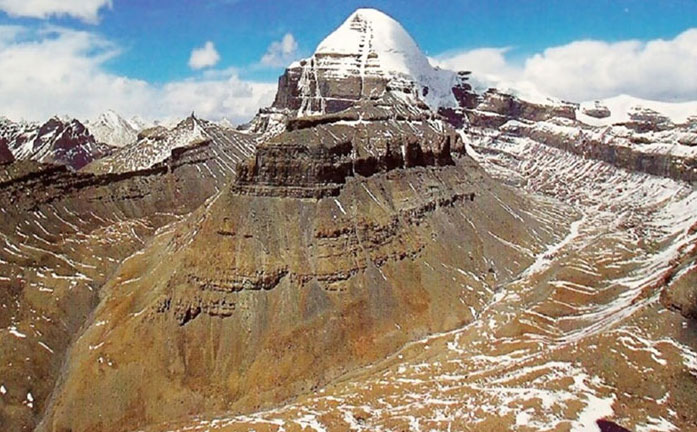
AhDI KAILASHA: Shiva Lingam
This is the AhdiKailasa, staircases to the heaven, the axis of the world and the pyramid temple palace of a dwarf divine ruler Shiva of ancient Bharata during the Satya Yuga. Kailasa is the Spiritual Center of the Universe, and it is astronomically situated at the Center of the Earth. Legend has it that dwarf divine ruler Shiva magically formed the AhdiKailasa overnight as his pyramid temple palace! Scientifically this story is untrue! The AhdiKailasa is the oldest pilgrimage Center on the Earth, and Center of the Universe. AhdiKailasa is a Four-Faced Pyramid, considered as Pillar of the World: on the southern side it has 54-natural staircases and unknown staircases on the northern side. The each Face of AhdiKailasa is 1. Crystal 2. Ruby 3. Gold 4. Lapis Lazuli. AhdiKailasa is situated in the heart of six mountain ranges symbolizing a Lotus on the Himalayas. In Samskritam Kelāsa means "Crystal". A few verses in the Vishnu Purana described that Kailasa has Four Faces and each are made of Crystal, Ruby, Gold, and Lapis Lazuli. The Kelāsa pyramid is standing 21,778 feet from the sea level. The body of the Kailasa pyramid is lay on the earth's magnetic field and around the world five man made pyramid monuments were built to emulate pyramid AhdiKailasa. Nearby a huge waterfall plunges into the earth and Four-Rivers flow into the Four directions of the earth. Some historians believe that the pyramid of Egypt built to emulate AhdiKailasa on the earth's magnetic field. The Uxmal Pyramid of Maya at the southeastern Mexico, and Toltecs Pyramid at Tula and Teotihuacan Pyramid especially built to emulate AhdiKailasa on the earth's magnetic field. The legend has it Uxmal Pyramid of Maya also built by a dwarf divine ruler over night. There is a correlation between Indus AhdiKailasa and Uxmal Pyramid of Maya at southern Eastern Mexico. The people at the Uxmal Pyramid unaware of the ancient history even though they tell the tales of Maya divine ruler magically built Uxmal pyramid over night and there is a overlapping pyramid at the under world on the tropical of cancer, which is the Indus Himalaya. The ancient Hindus consider AhdiKailasa is the holiest place of Shiva and it is also known as Shiva Temple Palace. Pilgrimage: Pilgrims circumambulates 32-mile (52-km) trek of AhdiKailasa three-days trek called Korato wash away all the sins of one's lifetime. Some Rishis/Pilgrims circumambulates around the AhdiKailasa arduous trek for 108 times to attain Nirvana.
Asuran Immortal Noble Emperor MahaBali
The Asuran Emperor MahaBali's reign after the famous Churning of the Cosmic Ocean, which is the Samudra Manthana. An ancient historical story: in a fierce battle between the Devas and the invading barbarian Asuras, finally the Devas were defeated and Asuras were led by Bali was victorious and he was crowned as the ruler of a divine land Bharata and he establishes a capital on the Narmada River, an ancient name was Rewa River, at today's Madhya Pradesh. The Devas sought help from divine Vishnu who advised them to treat the Asuras in a diplomatic manner because they were demonic barbarian human race. The invading Asuras were from ancient continent MU OR MANU. In the Treta Yuga continent ManU was 5,000 mile long from North-West to South-East, almost parallel to present day Central and Southern America and 3,000 wide from West to East in the Pacific Ocean, which is the present day Hawaii associates with all the nearby Islands. For ancient Bharatians it was close to the Patala Loka. The Indus Devas formed an alliance with Asuran ruler Bali to jointly Churn the Cosmic Ocean for Ahmrta, which is the drink of immortality and to share it among them. The churning of the Cosmic Ocean for Ahmrta was an elaborate process that took a thousand year in the Treta Yuga. The Mount Mandara, once it stood between two great lakes on the Himalaya, and it was used as the Churning rod, and Vasuki, the king of divine serpent became the Churning rope. [The famous world's tallest Mount Meru once stood on top of Himalaya. The plan was to cut-down the Mount Meru before entering Dwapara Yuga because it was tallest pillar mountain in the world to prevent odd earth's orbit around the Sun]. The Asuras demanded to hold the head of the Vasuki, while the Devas taking advice from Vishnu, agreed to hold a Vasuki's tail. During the Churning, the demons were poisoned by the fumes emitted by Vasuki and such poison still remain to this day in one of the smaller Lake on top of the Himalaya. Divine Vishnu in the form of a Turtle Kurma supported sinking Mount Mandara on his back. Samudra Manthana took place at the end of Treta Yuga approximately one million years ago. Asuran Bali ruled ancient Bharata peacefully for thousands of years and his subjects were happy under his reign and he earned the title Emperor MahaBali. About 74,000 years ago continent ManU, the present day Hawaii began to plummet into the Pacific Ocean when the Indonesian Mountain Toba 100x60-miles wide super volcano violently erupted breaking Indonesia into 17,400 islands. Presently, in the Pacific Ocean numerous Hawaiian chains of Islands are remains at the original site of continent ManU. In ancient Bharata, Emperor MahaBali's fame and prosperity has reached the heavenly planet and even the divine Vishnu became jealous of his fame. During the Treta Yuga, in Bharata, it was a difficult political process to remove an Asura noble Emperor MahaBali from his throne. So, Rishis of ancient Bharata eventually appealed to the divine Vishnu through numerous Yajna to intervene before entering onto Dwapara Yuga and Vishnu took a Vamana avatara in the form of a dwarf mendicant Brahman with his three requests to deceive a noble Emperor MahaBali on the day of his final One Hundredth Yajna. The MahaBali's adviser sage Shukracharya understood the Vamana was not an ordinary dwarf Brahmin and he tried to block MahaBali to promise anything to Vamana. Unfortunately, the benevolent prosperous Emperor MahaBali had promised to dwarf Vamana to irrevocably grant three feet of land as he requested. The dwarf Brahmin had grown taller as a huge divine human an avatara of Trivikrama reaching the heaven, and his first Footstep covered the First face of the earth, second Footstep covered the heaven then there was a problem for his third Footstep. The Asura noble Emperor MahaBali understood the divine form and he kneed before the Trivikrama avatara divine Vishnu, to make his third Footstep over his head. As a result of the great political compromises Emperor MahaBali agreed to return to his motherland continent ManU, which is close to present day Patala Loka vowing that he will return to Bharata Once a Year. Emperor MahaBali's request was granted by Vishnu to visit his former kingdom Bharata. This ancient story of Emperor MahaBali is warned throughout Bharata because of the numerous foreign invasions like Africans from 2150 BC through 1200 AD: mass migration from Northern and Eastern Africa onto Bharata. In 484 BC, Greek historian Herodotus was born in the Persian Empire and he detailed his encounters during his visit to Western Bharata where he met heavily populated Africans, also Ethiopians. In 327 BC, AMacedonia invasion for twenty two months decimated African tiny kingdoms across Western Bharata and some Africans have returned to Africa and a vast majority of the Africans were pushed to Eastern and Southern Bharata. Alexander's Greek general ruled their conquered Western Bharata for 20 years from the capital of Taxila. A New Greek invasion from Persia, founded Indo-Greek Empire in 180 BC and they ruled for 190 years at the North-Western region of Bharata. The Scythians invasion from Central Asia founded the Indo-Scythian Empire in 110 BC and they ruled for 505 years at the Western Bharata. Central Asian Kushans founded Indo-Kushan Empire around First AD through 30 AD and they ruled until 375 AD at the Western Bharata. From Persia, Greek assimilated Persians invaded Western Bharata forming an Indo-Parthian Empire from 12 BC through 130 AD for 142-years at the Western Bharata. These foreign barbarians (English terminology: Aryan) rulers have decreased African populations dramatically, pushing them to Eastern and Southern Bharata. Around 1050 AD, from Asia Minor Islamic rulers numerous times invaded Western Bharata and various Islamic rulers have changed the demographic and histories of ancient Bharata, dismantling twenty Hindu schools, especially Nalanda University in 1197 AD and numerous temples forever. The European dominations and finally the British Empire through 1946 have further changed the demographic of Bharata and her histories warned forever. In the Kali Yuga, Emperor MahaBali's story is only retained in the Southern Bharata, where today's Kerala people, regardless of their religious beliefs, celebrate Ten days festival called ONAM in the honor of a noble Emperor MahaBali. Note: from the 200 BC through the First century AD, the African origin Pandya rulers built a large Temple City complex perhaps for MahaBali at MahaBalipuram, South-Eastern Bharata. The MahaBalipuram recorded history states that even the heavenly bodies were jealous of the beautifully built Temple City, and the gods sent the tremendous forces of water waves to submerge it. In fact, Indonesian mega tsunami destroyed the Temple City complex say around 250 AD. The African origin Pallava kings, who ruled that region between 580 AD through 728 AD, beautifully rebuilt the MahaBalipuram Temple City atop of the remains of the older Temple City complex. Unfortunately, again a major eastern portion of the well-planned solid stone Temple City complex was dismantled by the series of mega tsunamis generated by the Indonesian Krakatau volcanic eruption in 852 AD, submerging part of the Temple City into the Bay of Bengal shores. Presently, only western part of the MahaBalipuram Temple City complex is standing for visitors to enjoy and imagine the glory days of Pallava kings. In the MahaBalipuram visitor can witness the ancient human Evolution Tree also.
Banij Gandhi - - Mahātmā Gandhi
Mahātmā Mohandas Karamchand Gandhi
There is a parallel modern historical story to the ancient story of Asuran immortal Emperor MahaBali of Tetra Yuga. In the Kali Yuga, Bharata was invaded by the Greeks, Asia Minor Islamic rulers, Portuguese, French, Dutch, and finally by the British Empire for nearly nine hundred fifty years. It was a difficult political process to remove the British Empire from Bharata. I am taking a wild guess here, divine was reborn in the form of a Baniya caste, a strict vegetarian family man and he has suffered many years of political struggles, prison terms, even though he was educated as a British Barrister (Attorney), and at last he attains his goal in removing the British Empire from Bharata in a peacefully. A political peaceful freedom fighter was a Mohandas Karamchand Gandhi who earned a divine title Mahātmā. Finally, Mahātmā Gandhi gave his life for his divine land Bharata, only five and a half months after the independence of Bharata - this could be a Divine's Plan! Can any readers able to see the correlation between Vishnu's Vamana avatara in the form of a dwarf Brahman and British educated barrister Mahātmā Gandhi? Note: Chapter four, versus seven of the Bhagavad Gita's prophecy has been partially fulfilled. Three great things took place in 1869: Mohandas Karamchand Gandhi was born on October 2, 1869 AD, on November 17, 1869, Highway to Bharata canal was opened for business and on May 10, 1869 United States made railway line connection from East to West coast, California.



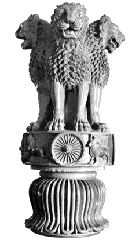


Left: An Ancient Hindu Kingdom Emblem, 3500 BC *Middle: Seal of Emperor Ashoka 250 BC and Modern Bharata's national emblem*Right: National Flag of Modern Bharata.
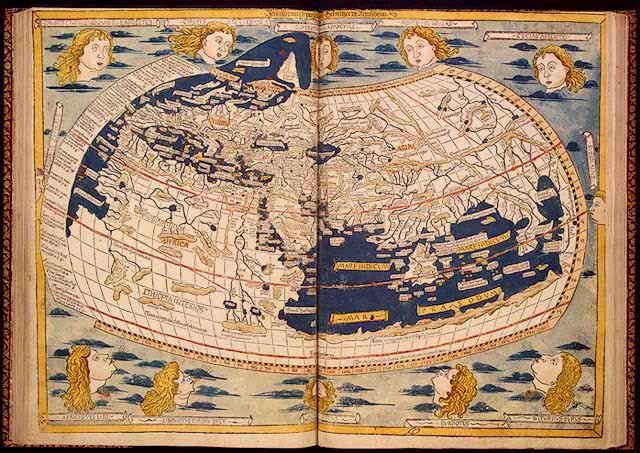
 Columbus and Spaniards - 1492 AD
Columbus and Spaniards - 1492 AD
Christopher Columbus set sail in an era of maritime, charting his route with the aid of a mariner's compass, an astrolabe, a cross-staff, and a quadrant. The popular map for mariners at the time was Ptolemy's Geography or Cosmography, printed in 1482 AD but compiled by the Alexandrian geographer, astronomer, and mathematician Claudius Ptolemy in the 2nd century AD

BharataRasaba : once stretched to Northern Africa, entire regions of Central Asia into present day Europe, Middle East, Bharata, South East Asian Nations and some regions of North, Central, and South American continent. The ancient Bharatians migration to various parts of the ancient World began over two million years ago. The new finding Harappans civilization is older than 9,000 BC. Anasazi reached ancient American west about 18,000 years ago from Central Asia and Northwestern Bharata. Sri Lankans reached South American Amapa, Brazil approximately 11,000 years ago after the Ramayanam War. Around 240 BC Emperor Ashoka sent Buddhist missionary to Central and Southern American regions once known as Patala Loka: the famous ancient ports Khetumala and Ichpa of Maya Empire such good examples. The trade between Patala Loka and ancient Bharata continued for thousands of years. Brazilian Indigenous Sri Lankan origin Tribes mainly lives in the Maranhao province of Brazil on the southern Amazon River: See on Wikipedia:  Tribes.
Tribes.
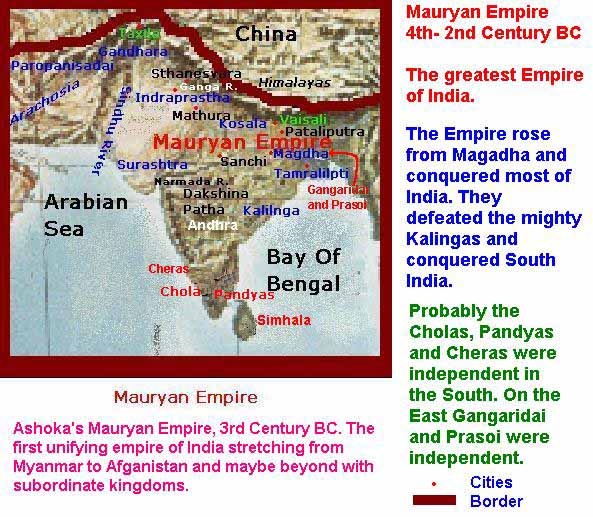

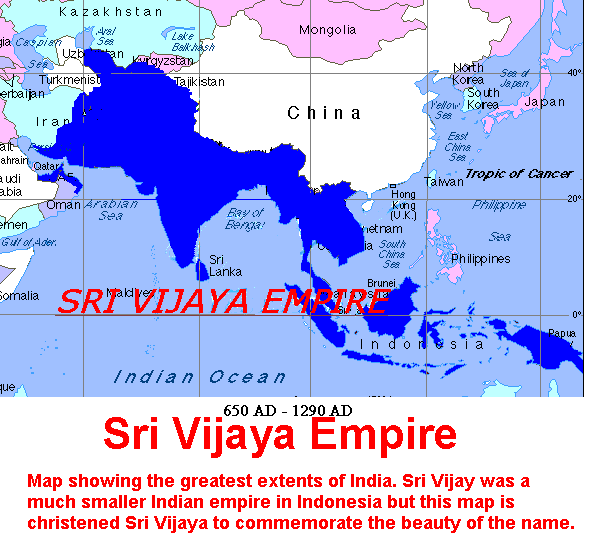
The World War MahaBharata has taken place in 3115 BC, in the regions of entire Central Asia, Middle East, eastern Europe, ancient Bharata, and Far Eastern Nations, not only indigenous to ancient Bharata as Bharatians have imagined OR misunderstood. The future World War Mahabharata may take place in the same designated regions OR in the region of Middle East and that could be a Divine's Plan! OR World War may not take place, instead earth may flood partially.


Prambanan Tamale/Tamil Hindu Trinity Temple complex in Central Java, Indonesia - built to emulate Mount Meru and astronomically accurately oriented towards Mount Meru / perhaps AhdiKailasha
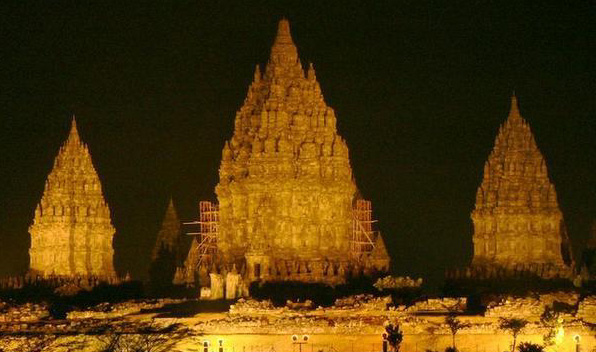
Right: Prambanan Tamale Hindu Temple complex in Central Java, Indonesia and it was built to emulate Mount Meru

Cambodia: Vishnu temple complex of Angkor-Wat is 80 to 400 square-miles wide – The marvelous Hindu architecture - highest peak of the temple was built to emulate Mount Meru and astronomically accurately oriented towards Mount Meru / probably AhdiKailasha. The Angkor-Wat is the largest Vishnu temple complex in the world.
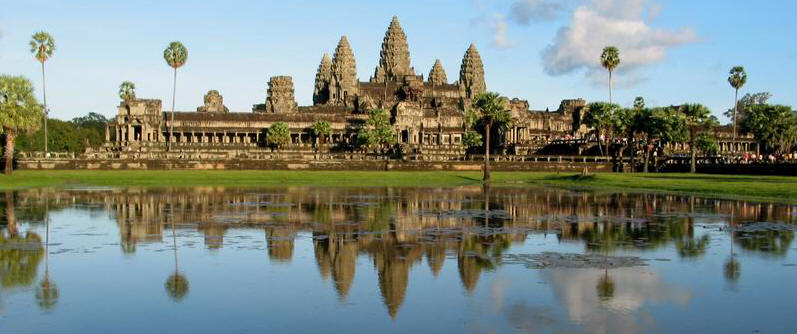
Vishnu temple complex - marvelous Hindu architecture of Divakarapandita, - built to emulate Mount Meru and Four other highest mountains of the world. Built during the reign of Maharajah Suryavarman II 1114 AD – Srindrajayavarman 1327 AD
 A: Albino street People of modern Bharata
A: Albino street People of modern Bharata
 B: Emblem is an Astronomical Map of the Earth [Cosmic Dance] of Bharata NOT a Jewish Star of David as popularized.
B: Emblem is an Astronomical Map of the Earth [Cosmic Dance] of Bharata NOT a Jewish Star of David as popularized.
 C: Ramayana: Ancient Sita Temple
C: Ramayana: Ancient Sita Temple 
 1: Ancient Bharata during the Vedic Era: BharataRarsba
1: Ancient Bharata during the Vedic Era: BharataRarsba
 2: Maurya Empire Unites Ancient Bharata as one nation
2: Maurya Empire Unites Ancient Bharata as one nation
 3: The Post-Maurya Empire era
3: The Post-Maurya Empire era
 4: Bharata's symbolism - Golden Age of Bharata
4: Bharata's symbolism - Golden Age of Bharata
 5: List of Kings who reshaped Bharata's Destiny after the MahaBharata War.
5: List of Kings who reshaped Bharata's Destiny after the MahaBharata War.
 6: Rajput Prithviraj
6: Rajput Prithviraj
 7: Indus Resist Muslim Aggression
7: Indus Resist Muslim Aggression
 8: Great Chattrapati Shivaji Maharajah
8: Great Chattrapati Shivaji Maharajah
 9: Pre-British Rule of Bharata
9: Pre-British Rule of Bharata
 10: Hinduism: Essence of Bharata
10: Hinduism: Essence of Bharata
 11: Indus OM, OMkar and Swastika
11: Indus OM, OMkar and Swastika
 12: Lost Continent of Atlantis
12: Lost Continent of Atlantis
 13: Hindu concept of ZERO - Mathematics
13: Hindu concept of ZERO - Mathematics
 14: Indus Sati and Child Marriages
14: Indus Sati and Child Marriages
 15: Hindu Yajna, Dana and Gotra
15: Hindu Yajna, Dana and Gotra
 17: Indus' Varna Caste System in Vedic Era
17: Indus' Varna Caste System in Vedic Era
 18: Hindu History: Two Main Classes
18: Hindu History: Two Main Classes
 19: Indus History: Jati-Varna Matrix
19: Indus History: Jati-Varna Matrix
 20: Popular Hindu Festivals-1
20: Popular Hindu Festivals-1
 21: Popular Hindu Festivals-2
21: Popular Hindu Festivals-2
 22: Indus History: Religious Tolerance
22: Indus History: Religious Tolerance
 23: Buddhism: Our Message of Peace
23: Buddhism: Our Message of Peace
 24: The Jaina religion or Jainism
24: The Jaina religion or Jainism
 25: Ancient Indus Philosophical School
25: Ancient Indus Philosophical School
 26: The Hindu History - Sikhism
26: The Hindu History - Sikhism
 27: The Hindu History - Christianity
27: The Hindu History - Christianity
 28: The Hindu History - Judaism
28: The Hindu History - Judaism
 29: Persian Zoroastrianism
29: Persian Zoroastrianism
 30: Brāhmī Script, ancient Samskritam Languages of the World
30: Brāhmī Script, ancient Samskritam Languages of the World
 31: Hinduism: 33 Gods in Vedas
31: Hinduism: 33 Gods in Vedas
 Video 1: Bharata-1
Video 1: Bharata-1
 Video 2: Bharata-2
Video 2: Bharata-2
 Video 3: Bharata - 3
Video 3: Bharata - 3
 Video 4: Bharata - 4
Video 4: Bharata - 4



Kalpana Chawla, 41, immigrated to United States from Bharata in 1980's and she became a First Bharatiya American astronaut in 1994. Kalpana Chawla's First Columbia space shuttle mission was on November 19, 1997 and she was the first Bharatiya American astronaut began her career at the Ames Research Center at NASA in 1988. Kalpana Chawla earned her aerospace engineering doctorate from the University of Colorado in Boulder and she trained more than 376 hours in space as a prime robotic arm operator since her first Columbia shuttle flight begun in 1997. NASA selected Kalpana Chawla as an astronaut candidate in 1994 and she joined the fifteenth group of astronauts in March 1995. In 1988, Kalpana Chawla, PhD started work at NASA Ames Research Center in the area of powered-lift computational fluid dynamics. NASA assigned Kalpana Chawla to the crew of STS-107, as her second space shuttle Columbia mission that was launched on January 16, 2003. While returning to the earth, the 'Space Shuttle Columbia' exploded entering into the earth's atmosphere along with crew her crewmembers on First of February 2003.
NORAH JONES



Geetali Shanker Norah Jones (Daughter of World Famous Sitar Player Dr. Ravi Shanker): Pop-Jazz Singer Norah Jones Winner of 8 Grammys in 2003

2150 - 2000 BC BHARATA
Ancient Bharatians have migrated across the greater Central Asia, Middle East, and Eastern European peninsula tens of thousand years before the World War MahaBharata of 3115 BC. The earth's last Ice age is one of the best evidence, some date back to 40,000-years and others dates back to 25,000-years. A vast majority of the greater Eastern Europeans, and Central Asians including Abkhazians, Ossetians, Scythians, Persians, and the modern Turks were origin of ancient Bharata.Note: BBC televised a DNA analysis back in1982 about African Albanos and ancient Bharatians. In this report about 30,000 years ago, tall (15-18ft) well-built white race Bharatians have migrated across the Central Asia to the European peninsula assimilating with the migrated African Albanos – forming a white race what we see today. All the ancient languages spoken between the years 30,000 to 5,000 in the ancient Bharata are spoken in the modified version in the current Central Asian and European peninsula, famously known as the Indo-European language families. DNA: Prior to the World War MahaBharata, some Central Asian tribal societies (Tula) have migrated to ancient America, and those societies continued their Indus Dharma in their newly founded land including Harapans and Toltecs from Tula Central Asia . The Vedic era Paganism spread across the Middle East, Egypt, northern Africa, Central Asia, Far East, Eastern Europe, Asia Minor, Greek peninsula, and Roma Empire. In 484 BC, the Modern Greek historian Herodotus was born in the Western region of Persian Empire. Young Herodotus traveled to his parents' homeland Greece, later he further traveled to Egypt-Africa-Aethiopia, Middle East, Hebrew land, and finally reaching Taxila, Bharata. In his book Herodotus detailed his encounters during his visit to Taxial / Takshashila University region of Western Bharata where he met densely populated Northern Africans, specifically ancient Aethiopians, also known as Abyssinians, modem day Ethiopia, the Kingdom of Kush: the inhabited world according to Herodotus. See the map of Northern Africa-Aethiopia. (Amharic an Afroasiatic language of the Semitic branch an Ethiosemitic group and the modern Ethiopian mother tongue is Amhara). About 9,000 years ago, the Indus-Harappan civilization populated Middle East and Egyptian peninsula. In the modern Middle East the Indus town names Suriappa, Rudrappa, Karma, Brosiappa, Muthanna, Black King Cobra temple, Khayappa, Baja, and Harish and in Egypt OM, Nagamadi and Rani to name a few still remains. Sea trading between ancient Bharata and the Middle East-Africa continued for over 6,000 years. Northern African andEthiopian women wore a long cloth wrapped around their body without a blouse and their traditions continued in Bharata after a new mass migration of northern Africans and Ethiopians (Vedic era Pagans) onto Bharata, say around 2150 BC during the Egyptian civil war, which lasted for 150-years. Eventually African women's cloth worn around their body became a new Indus Sari style with numbers of Pleats on the Front also on the Rear wrapped around their waist, which is a modified version. Today, direct descendants of African tribal women living at the remote regions of Bharata continue to wear long cloth wrapped around their body without a blouse - see those images. There are eighty various Sari styles worn by the Indus women across the subcontinent of Bharata including Sri Lenke/Lanka. The royal Egyptian women's dress also worn by the Greeks, Roma Empire women and some modern western women also. Ancient Vedic era the Indus women's dress was Sattika in Samskritam is worn by the modern Islamic women of today. The Punjabis, Tamales/Tamils and Bangal Deshis do celebrate ancient Ethiopian New Year's Day, which falls on April 14/15 of Gregorian calendar, not a Vedic New Year's Day, the First Day of Chaitra, which is celebrated throughout Bharata including Persia and Turkey. In the Bharatian subcontinent over ninety percent of the inhabitants are African origin; assimilations and genetic mutation have taken place throughout the subcontinent. Thousands of African dialects are spoken across the subcontinent of Bharata including national language Hindi (Arwadi). However, Bharatian subcontinental people are ignorant in their origin of genetic assimilations despite DNA evidence and their skin and gum color. In Bharata migrated Africans in their new land elevated their status from salves to soldiers to generals, finally assuming the status of Rajahs establishing their tiny kingdoms across the Bharatian subcontinent and the Africans origin people have multiplied into billions across the subcontinent when the Islamic and the Europeans arrived in Bharata. Presently, densely populated ancient assimilated Africans live in the regions of Utra Pradesh, Bengal Desh, Gujarat, Orissa, Kerala, Tamale/Tamil land, Andra Pradesh, some parts of Karnataka, Sri Lanka/Lenke and sparsely populated across Bharata, Nepal and Pakistan. Note: the Humans have migrated across the globe for over two million years and the modern day human migrations across the world are one such good example. In this Kali Yuga, the glory days of Vedic era "Shanatana Dharma" will never going to return to divine land Bharata, Sri Lenke and Patala Loka as numerous Hindus are anticipating. There are three distinct human races on the earth and the human race NOT only evolved in the African continent. (1). Ancient human races evolved on the continent MANU - Six-million-years old (2). Humans in Bharata:- Four million-years old (3). In the African continent:- Three million-year old: from Apes to Human transformation has taken place also known as form of Avatara/Rupam. This process is widely known as Hanuman subcontinent of Bharata and it is unwise to worship a Hanuman. The First phase of Kali Yuga of 5,126 years, where earth's titled arc terminates in 2024 and a new era begins from 2025 CE. Eventually an astronomical event may takes place, dramatic changes across globe and such action may flood the earth partially. The modern astronomers states that the First phase of Kali Yuga may terminates by 2054 also known as Fifth North star appearance, moving to First North star. In the mean time Five major Nations are preparing for a new un-winnable nuclear World War III. The present day Kali Yuga may terminates approximately in 427,000-years, which is calculated in the end of Dwapara Yuga based on 24K-years revolution of tilted axis of the earth. After the Quantum shift from 108 to 109, say around 3102 BC, the present day Kali Yuga begun – 365-days-a-year cycle emerged from 360-days. So, the Indus Rishis revised the new earth's tilted axial revolution to 25,630-years and the modern astronomical version is 25,772-years. The present day Kali Yuga is much more the originally concluded 432,000-years. In the future numerous Islands across the world and some parts of the various continents will plummet into the Ocean: this has had happened before and it will happen again in the future. The Sun's Quantum Shift pushes the present day planetary orbital position a bit farther into the space. After the next Quantum Shift, the earth's new orbit may have 375-days-a-year and numbers of hours per day may increases to 26-hours and human life expectancy may decrease to 79-years from current 87-years. After 427,000-years into the final days of Kali Yuga, the human life expectancy would be only 20-years and earth's orbit would be at the previous orbit of Mars where planet earth will be in the unlivable status. The planet Venus will be at the original orbital position of the Earth before the Satya Yuga was began and eventually animal and human evolution may emerges on the planet Venus.
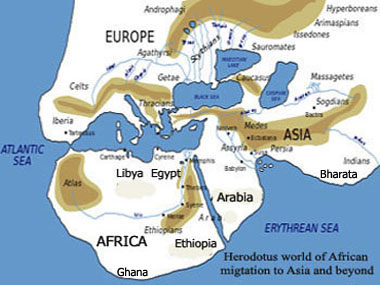


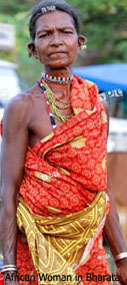
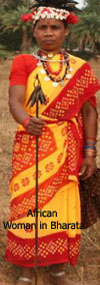
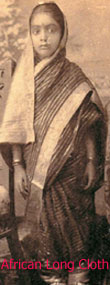
The Sattika was the ancient Indus women's attire in Samskritam worn during the Vedic era, in the Dwapara Yuga. The ancient African women wore a large Bindi on their forehead with some facial marking. The ancient Indus women wore tiny Bindi in-between their eyebrows, which is a tiny atomic black symbol. The elite Vedic Brahmins classified the new African migrants as untouchable lower caste; Ahdharmasya and their caste status are remains to this day. In the Bharatian subcontinent people with dark to black gum color and dark to black skin colored inhabitants are one hundred percent African origin. In order to avoid the unprivileged Indus caste systems majority of the lower caste untouchable people were converted into Buddhism, Christianity and Islam. In the future of Kali Yuga, the unethical faiths including Buddhism, Christianity and Islam will be fazes out restoring peace on the earth for 10,000 years of golden age. All the worldly political activities would run according to the Indus Bhavishya Purana.

 Sri Lankan Origins of the Olmecs
Sri Lankan Origins of the Olmecs
In 635 AD, first Islamic Mesopotamian (Iraq) invasion on the Bharatian soil
In 1754 AD, the last minor Islamic rule ended with the help of British
El Yamuna (Yemen) people were origin of ancient Bharata

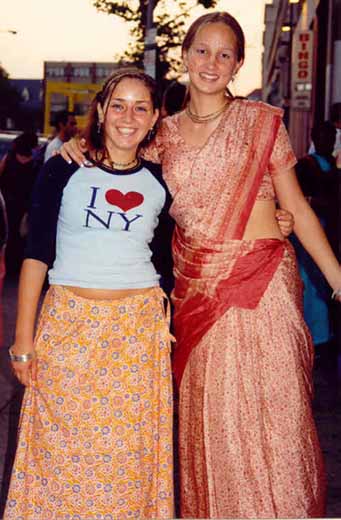
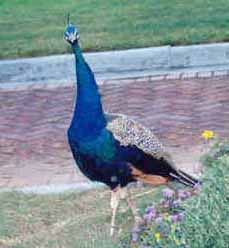
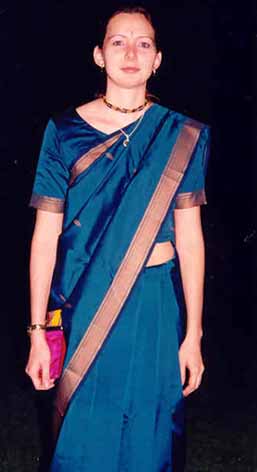
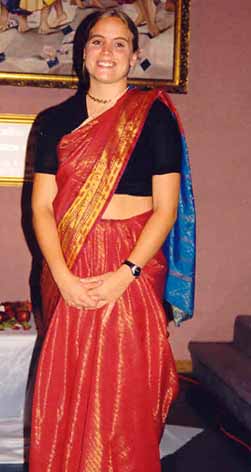
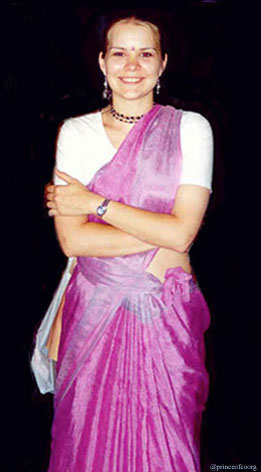
BHARATA: Root of all the Western Civilization:  Video: Ancient Bharata : Four Beautiful Indus Women
Video: Ancient Bharata : Four Beautiful Indus Women

"All humans are not created equal, race or religion and it is up to an individual to understand each other"
Think logically before you write : e-mail:
maha.rishi7@hotmail.com
You are the visitor
Since July 1997